12 SPORTS/Cross Country Wildcats come in 30th in NCAA Championship
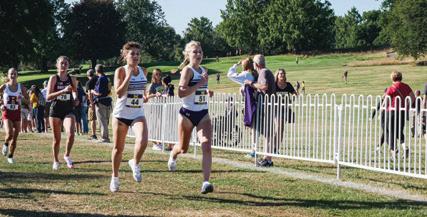
AUDIO/NU Declassified Professors, graduate students talk navigating academic burnout

4
OPINION/Mwangi
George R.R. Martin supports creative writing
By LILY CAREY daily senior staffer @lilylcarey
Evanston aims to become carbon neutral by 2050 — a goal that’s earned the city accolades as it navigates rising lake levels, extreme tempera tures and insufficient infrastructure.

To achieve carbon neutrality, the city needs
to counter its carbon use by removing an equal amount of carbon from the atmosphere, or by cutting emissions altogether.
For years, Evanston has relied on renewable energy to offset its greenhouse gas emissions. But much of the clean energy the city claims to use doesn’t change the amount of fossil fuels burned in Illinois. It’s produced and consumed out of state.
The city currently purchases energy credits
from wind farms in North and South Dakota, according to Sustainability and Resilience Coor dinator Cara Pratt. These credits, called Renew able Energy Certificates, allow cities to purchase units of renewable energy to offset their carbon emissions. However, using RECs doesn’t actu ally increase the share of renewable energy in Evanston’s local electric grid.
Field Hockey: NU falls 2-1 in national championship
Cats fail to beat North Carolina in NCAA berth
By GABRIELA CARROLL daily senior staffer @gablcarroll
STORRS, CONN. — North western’s quest to hold onto its title as national champions ended in heartbreak Sunday with a 2-1 loss against North Carolina.
The Wildcats (20-5, 5-3 Big Ten) looked outmatched for much of the game, failing to record a shot on goal until the waning minutes of the final period. But their defense stood strong, allow ing just one goal before NU got its first penalty corner opportunity
with just over two minutes to play in the contest.
Fifth-year forward Bente Baekers converted on the set play, bringing the Cats even with the Tar Heels and in position to take the game to overtime. But less than 40 seconds later, North Carolina star Erin Matson snuck past NU’s defense and redirected a Paityn Wirth shot into the net — the eventual game-winner.
“Credit to (the Tar Heels), and some credit that we were maybe a little bit off,” coach Tracey Fuchs said. “But I thought we fought for an entire game to stick with it, tie it late, but unfortunately, give up
that goal 40 seconds later.”
The Cats played from behind in the first half, as the Tar Heels took five shots in the first quarter and tallied two penalty corner attempts. Carolina also earned a penalty stroke in the first, and junior goalkeeper Annabel Skubisz turned Matson’s shot aside. Matson hadn’t had a stroke attempt saved all season, going five-for-five prior to Sunday.
Early in the second period, the Tar Heels earned their third penalty corner, but they bobbled the first pass and Skubisz made
» See FIELD HOCKEY, page 10
SOLR marches for NU staff access to dining hall meals
Staff report recent revocation of free meal access
By NICOLE MARKUS daily senior staffer @nicolejmarkus
Students Organizing for Labor Rights hosted a march across campus Friday to advo cate for Northwestern main tenance technicians who lost access to free dining hall meals.
SESP senior Neva Lega llet said staff informed SOLR this week that their access to dining halls, which they had earlier in the quarter and in previous years, was recently
removed. Maintenance staff must now pay $16 per meal, Legallet said.
“Sixteen dollars is an absurd amount to pay for any meal,” Legallet said. “They work in these dorms, they make these dorms function, (they) should be able to access every part of it, including the meals.”
About 15 students marched down Sheridan Road, stop ping at the Residential Ser vices building to deliver their demands and hang signs on the fences of Deering Meadow. Signs read, “SOLR DEMANDS MEALS FOR
MAINTENANCE STAFF” and “KEEP YOUR COMMU NITY FED.”
Some participants in the march criticized the Univer sity and Compass Group, NU’s food service provider, for their roles in removing the dining access.
“The idea that this wealthy institution that promotes itself as having liberal ideas would be treating (the staff) poorly, degrading them and not allow ing them to have a warm meal is deplorable and ridiculous,”
DAILYNORTHWESTERN.COM Find us online @thedailynu Monday, November 21, 2022 High 44 Low 27
The Daily Northwestern INSIDE: Around Town 2 | On Campus 3 | In Focus 4 | Arts & Entertainment 6 | Opinion 8 | Sports 12 Serving the University and Evanston since 1881 Recycle Me
» See RENEWABLE ENERGY, page 4
Evanston’s renewable energy comes from out of state. Are new solutions local?
» See SOLR MARCH, page 10
Illustration by Olivia Abeyta
District
By KUNJAL BASTOLA the daily northwestern @kunjal_bastola

Earlier this year, Evanston/Skokie School District 65’s Head Start Program, an early childhood learning center, received a $230,000 grant to upgrade a diesel-fueled school bus to an electric one.
The district received the grant from the state’s Driving a Cleaner Illinois Program, but the program did not receive more money to grow District 65’s electric bus fleet.
“We are disappointed to not have been selected in the latest round of funding,” Dis trict 65 spokesperson Melissa Messinger wrote in an email to The Daily. “We believe strongly in continuing to pursue this environmental ini tiative in accordance with our sustainability commitments.”
The district was already facing issues with transportation, including bus shortages, before it wasn’t selected for the grant.
“The largest part of our increase year over year in transportation costs is the rising fuel costs,” said Joseph Hailpern, a member of the District 65 school board and chair of the district’s Personnel, Building & Grounds and Finance Committee.
Halipern said the district needs to lessen its fuel dependency in order to align itself with Evanston’s Climate Action and Resilience Plan goals.
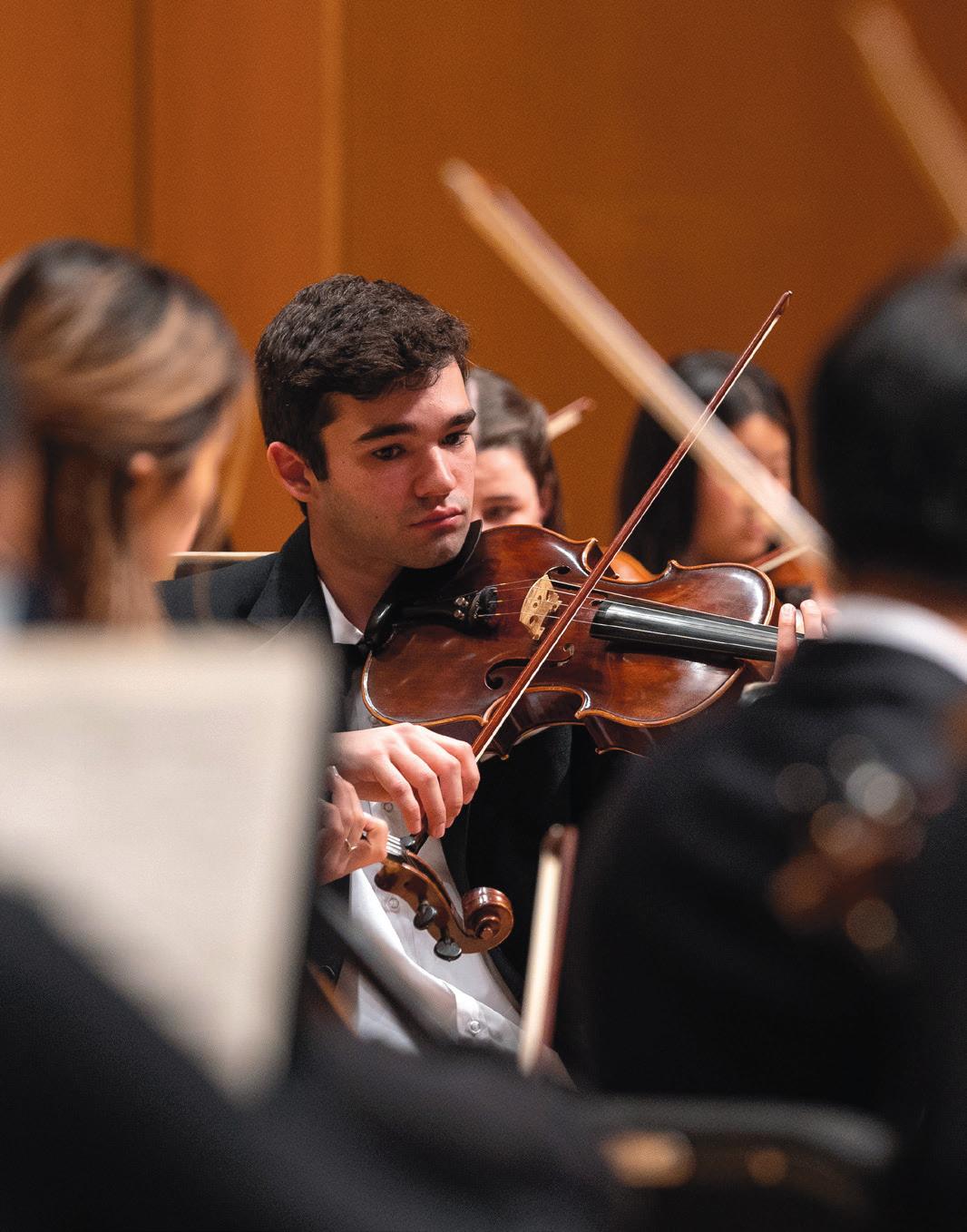
District 65 is still pursuing other grants to increase the number of electric buses, Halipern said.
But not everyone in District 65 thinks elec tric buses are the right way for the district to increase sustainability. District 65 teacher assis tant Kelliann McArthur said converting the fleet to be all-electric will not help its current students.
“I don’t know that switching to electric buses isn’t gonna help anything but the environment,” McArthur said.

McArthur said the transition has meant there
is now a shortage of buses. She highlighted that the district had to change school start and end times because there weren’t enough buses.
She added that sometimes buses do not arrive promptly after school and teachers have to wait with their students.
According to Julie Vogel-Lepley, a special education teacher at the Joseph E. Hill Early
Childhood Center, the shortage has meant some buses now have to take longer routes.
For students in the Special Education pro gram, being on the bus for too long can be over stimulating, and there has been work to begin to create routes specific for these students, she said. While it is unclear whether an electric bus fleet will alleviate these issues, advocates say
it will help with environmental and economic problems that diesel-fueled vehicles cause. But some community members disagree.
“Getting electric buses – yeah, it’ll help the children’s grandchildren, but it’s not doing any thing for the kids today,” McArthur said.
kunjalbastola2026@u.northwestern.edu
AROUND TOWN MONDAY, NOVEMBER 21, 2022 2 THE DAILY NORTHWESTERN
Chamber Orchestra Thursday, December 1, 7:30 p.m. Pick-Staiger Concert Hall, $6/4
W. A. Mozart,
35 in D Major (“Haffner”) Joseph
Berenice Ludwig
D Major (847)-467-4000 concertsatbienen.org The Daily’s Holiday Guide publishes on Thu, December 1 Last Fall print issue: Mon, November 21 First Winter 2023 print issue: Mon, January 9 Ad deadline: Thurs, December 15 Call 847-491-7206 or Email spc-compshop@northwestern.edu
Northwestern University
Robert G. Hasty, conductor; Kaytlin Withers, soprano (Concerto/Aria Competition winner)
Symphony No.
Haydn, Scena di
van Beethoven, Symphony No. 2 in
65 works to upgrade to electric bus fleet
Ysa Quiballo/The Daily Northwestern
District 65 continues to work toward receiving more grants, according to Joseph Hailpern, a member of the District 65 school board, in order to fund an electric bus fleet, as it faces challenges like bus shortages.
Students celebrate Indigenous heritage
By KHADIJA AHMED the daily northwestern
Content warning: This story contains mentions of death and anti-Indigenous violence.

The sound of drums, singing and the jingle of danc ers’ bells filled Norris University Center’s ground floor Nov. 10.
A purple decal of a land acknowledgment spanned some of the windows. Food from Ketapanen Kitchen, a Menominee catering service, included a spread with cloves of garlic and sweet potatoes, bison, squash and wild rice with berries.
The food tasting event, which also featured drum and dance performances, was part of a larger series of programming called “30 Days of Indigenous,” orga nized by Multicultural Student Affairs, the Center for Native American and Indigenous Research and the Office of Institutional Diversity and Inclusion in observance of Native American and Indigenous Heritage Month.
“I could taste the maple syrup in there. It was just a mouthful of flavor,” said Director for Native American and Indigenous Affairs Jasmine Gurneau. “I loved seeing that. It was hitting all of the senses — the taste and the smell and the sounds and the sights.”
This month’s programming centers on being a good relative, which Gurneau, who is enrolled with the Oneida Nation and a descendant of the Menomi nee Nation, said shows Native American and Indig enous communities’ layers of complexity. Gurneau said she hopes the programming conveys the many facets of Indigenous life and history, because there are more than 570 tribes within the U.S., each with its own customs, languages and constitutions.
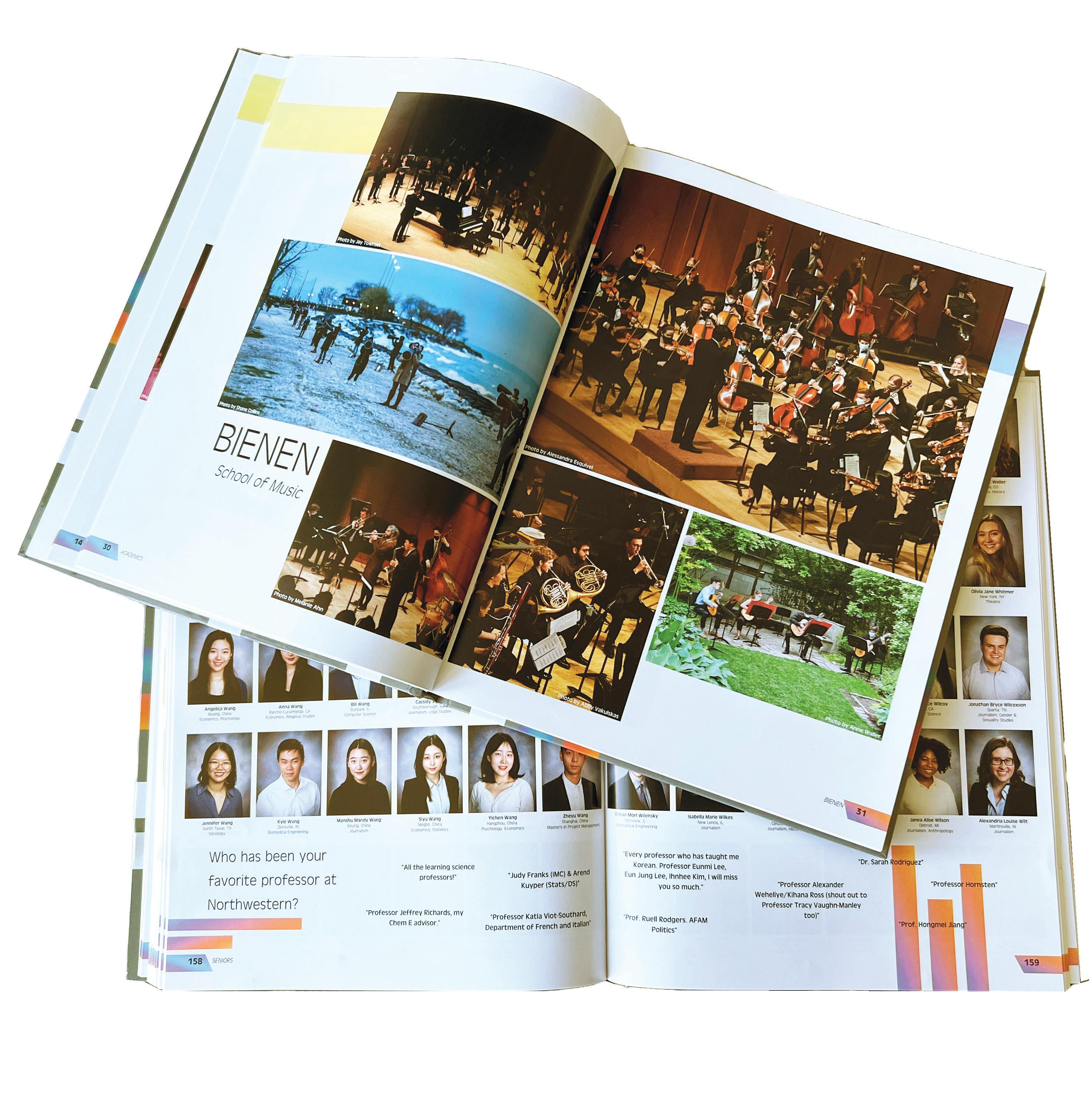
Gurneau said the Haudenosaunee peoples, which includes the Oneida, remember the seven generations before and the seven generations that will come after. She said it’s also important to be respectful of nonhuman relatives, such as place, land and waters.
“This month is really important for me, especially not being home this year or last year,” said SESP soph omore Athena GoingSnake, who is Muscogee Creek and a citizen of the Cherokee Nation. “Being a good relative means respecting and taking care of others
Two
around you, listening to people and your environment and going by what your elders say.”
MSA and the Office of Institutional Diversity and Inclusion, in collaboration with the Native American and Indigenous Student Alliance, also held a com memoration of the Sand Creek Massacre on Thursday.
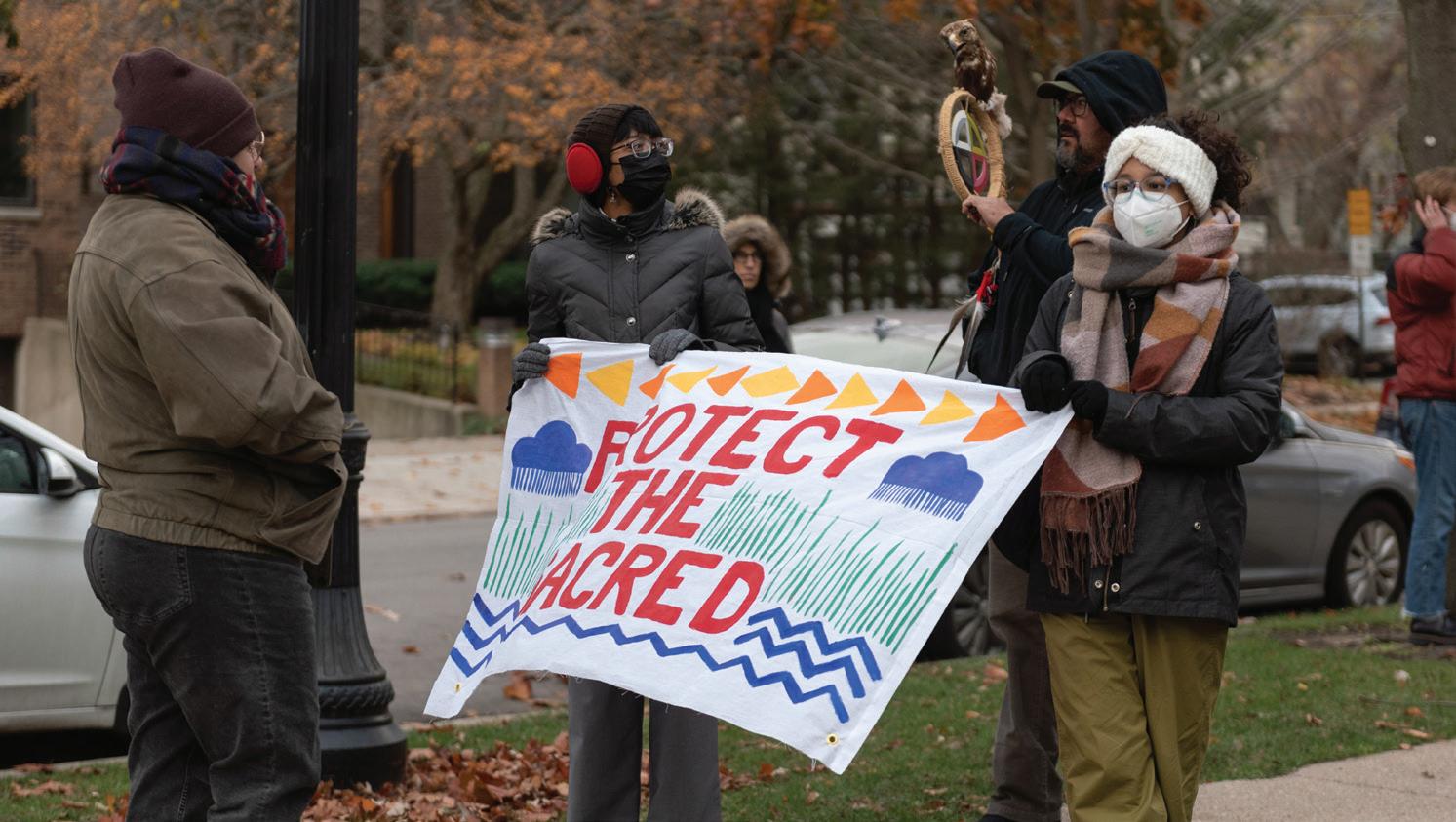
During the 1864 mass murder, the U.S. Army killed about 230 Cheyenne and Arapaho people. In obser vance, 158 years later, attendees walked in a procession and heard from Indigenous students and community members.
“It’s a hard topic to talk about, but it’s necessary to bring people in to have these difficult conversations,” NAISA co-chair GoingSnake said. “I loved the proces sion afterward, drinking hot chocolate and getting to talk to people in my community. It was restoring — something I needed.”
Northwestern co-founder John Evans was involved in the Sand Creek Massacre, according to a report from the University of Denver. In its own report from 2014, NU said Evans had no advance knowledge of it.
On Thursday, the Colorado Geographic Naming Advisory Board voted unanimously to rename Mount
Evans to Mount Blue Sky. The change will be finalized after it is approved by the Colorado governor and the U.S. Board on Geographic Names.
“It’s incredible and a step in the right direction, recognizing what has happened in the past and finding restorative ways to move past it and for everyone to heal,” said SESP sophomore and NAISA Treasurer Alivia Britton, who is Odawa.
GoingSnake said the name change is an impor tant step in increasing sovereignty rights and the visibility of Native people. Britton said in schools, Indigenous people are talked about as if they only exist in the past.
GoingSnake and Britton said it’s crucial for the University to issue a formal acknowledgement of Evans’ role in the Sand Creek Massacre and apolo gize for its previous report.
“Northwestern tends to hide from its history, and I think now especially is the time to just step up in this moment and to stop being a coward,” Britton said.
khadijaahmed2025@u.northwestern.edu
The Daily Northwestern www.dailynorthwestern.com
Editor in Chief Jacob Fulton eic@dailynorthwestern.com
General Manager Stacia Campbell stacia@dailynorthwestern.com
Holly and John Madigan Newsroom
Phone | 847.491.3222

Campus desk campus@dailynorthwestern.com City desk city@dailynorthwestern.com Sports desk sports@dailynorthwestern.com

Ad Office | 847.491.7206 spc-compshop@northwestern.edu
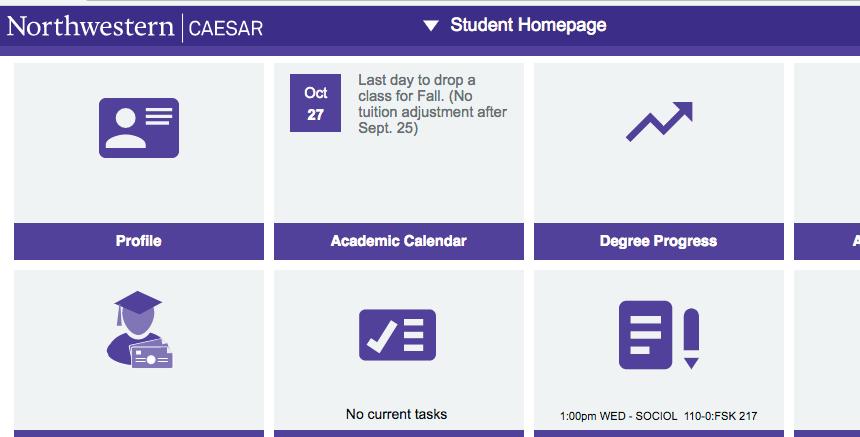
The Daily NorThwesTerN is published Monday and Thursday during the academic year, except vacation periods and two weeks preceding them and once during August, by Students Publishing Co., Inc. of Northwestern University, 1999 Campus Drive, Evanston, IL 60208; 847491-7206.
First copy of The Daily is free, additional copies are 50 cents. All material published herein, except advertising or where indicated other wise, is Copyright 2020 The Daily NorThwesTerN and protected under the “work made for hire” and “periodical publication” clauses of copy right law.
POSTMASTER: Send address changes to The Daily NorThwesTerN, 1999 Campus Drive, Evanston, IL 60208. Subscriptions are $175 for the academic year. The Daily NorThwesTerN is not responsible for more than one incorrect ad insertion. All display ad corrections must be received by 3 p.m. one day prior to when the ad is run. Check out DAILYNORTHWESTERN.COM for breaking news
Order your 2023 yearbook on CAESAR FOR INFO AND ALL THINGS YEARBOOK VISIT www.NUSyllabus.com 1. Log on to CAESAR 2. Click "Profile" 4. Check "order" and click save 3. Click "Syllabus Yearbook Orders" SAVE 10% if you order the 2023 Syllabus yearbook today! ON CAMPUS MONDAY, NOVEMBER 21, 2022 THE DAILY NORTHWESTERN 3
Esther Lim/The Daily Northwestern
people hold a sign reading “Protect the Sacred” prior to walking in a procession for the Sand Creek Massacre commemoration, starting at the John Evans Alumni Center.
Clean energy advo criticized the city for approach. The Evanston ment Board has debated internally for several member Matt Cotter
“If our only strategy emissions energy is pur chase of RECs, is that in the spirit of reducing our emis sions?” Cotter asked.
But if city government chooses to move away from this system, find ing alternatives that reduce emissions as effectively could be a challenge.
According to Evanston’s current environ
mental plans
Climate Action and Resil ience Plan — all cityowned facilities should use 100% renewable energy by 2030.
Residents have called out the city for its inac tion. In response, City Council declared a cli mate emergency last spring to prioritize clean energy through legislation.
As a result, for some Illinois towns buying green is no longer worth the potential cost. ComEd rates fluctuate, which doesn’t always benefit CCAs. The company’s rates were arti ficially high in the late 2000s and early 2010s, Nieuwsma said, but they eventually stabilized, becoming more affordable than some CCA rates. Some towns that opted into the fixed-rate program while ComEd prices were high regretted the decision.
Across the state, 746 local governments have had CCAs, according to a database from Plug In Illinois. About 43% of these contracts are expired or set to expire, according to data last updated in October.
Over the years, price fluctuation has prompted many Illinois municipali ties to shut down their CCAs. Across the state, 746 local governments have had CCAs, accord ing to a database from Plug In Illi nois. About 43% of these contracts are expired or set to expire, according to data last updated in October.
when ComEd rates are updated each year, DeBor toli said. Based on who MC Squared deems eli gible, residents can be added to or dropped from the CCA.
DeBortoli said this may have been the source of initial confusion, because energy users received varying messages about their status in the program.
“(The review is done) to see who should be on the program to the benefit of the town,” DeBor toli said.
She declined to say how the review was con ducted, saying the knowledge was “proprietary.”
The Daily also requested records of a ward-byward breakdown for which accounts were on the CCA, but the city said MC Squared only tracks citywide data.
According to city records, nearly 30,000 accounts are eligible for Evanston’s CCA. Yet today, only about 7,650 of those accounts are technically on the system.
“The majority of people that I spoke to really wanted to be a part of the program, and there was some frustration that they weren’t automatically included,” Pratt said.
authority to pat (itself) on the back and claim legally that (it) used 100% renewable energy,” Sprague said.



“(RECs) are a legal fiction,” he said.
Though they don’t actually change the amount of fossil fuels being burned locally, RECs create a major carbon offset on paper. The city subtracts the MWh of RECs purchased annually from the MWh of energy used citywide.
According to a 2019 presentation by CGE, RECs accounted for 44.8% of Evanston’s emission reduction from 2005 to 2017. This represents a significant proportion of Evanston’s carbon off sets from its carbon footprint, Pratt said, as the elimination of RECs would have resulted in a 2% increase in citywide carbon emissions from 2020 to 2021.
As a result, removing RECs from Evanston’s clean energy conversation could derail efforts to achieve carbon neutrality by 2050.
But Pratt said the city’s Environment Board and Utilities Commission “have expressed inter est in thinking about alternatives to purchasing RECs.”
Still, RECs have sparked confusion and controversy in Evan ston and beyond. Many residents say they’re unsure how the city’s renewable energy system works, and some have discussed more community-oriented and financially accessible energy networks.
Now, advocates are searching for more direct solutions to Evanston’s clean energy puzzle.
How does the current system work?
More than 7,500 Evanston residents are enrolled in the city’s community choice aggre gation program, according to city records obtained by The Daily. The program connects residents to renewable energy — but it does so by purchasing RECs. Evanston’s CCA began operating in 2012 and is the city’s most widely used renewable energy system.
Illinois has a deregulated energy market, which means actual energy providers are sep arate from the suppliers listed on residents’ energy bills.
Residents on the CCA still use energy dis tributed by ComEd, Evanston’s utility company that delivers energy to residents and handles payment. It’s the energy supplier itself that changes — the city purchases RECs from a supplier, and in exchange the city’s name is attached to that clean energy production.
Under a CCA, the Utili ties Commis sion finds an Alternative Retail Elec tric Supplier on behalf residential and small energy users in the net these accounts are then to the network.
“Aggregation … allowed municipalities to negoti on behalf of everybody in community, and sign up entire community with an ARES for a better rate,” Ald. Jonathan Nieuwsma (4th) said. “In one fell swoop, you sweep everybody in the community into a better deal.”
Individual users can shop around and choose their own energy sup plier if they want, accord Citizens’ Greener Evan ston board member Joel Freeman. But residents and small businesses often struggle to find the best deals on their own.
Negotiating on a city wide level through a CCA increases buying power and can help residents and small businesses get “the same shopping advantages as the big guys,” Freeman said.
To form a CCA, the city engages in a com petitive bidding process. Evanston’s past con tracts have usually lasted between one and three years. Residents can opt out of the CCA at any point, but risk a shift in their energy
- LILY CAREY
Evanston never let its CCA go defunct, mainly because it created significant carbon offsets. Without the CCA, the city wouldn’t be close to reaching its climate action goals, according to a 2019 CGE presentation.
So when Evanston’s last CCA contract expired in 2020, city officials needed to main tain residents’ access to clean energy without exceeding ComEd rates, Nieuwsma said.
MC Squared: A new solution?
In April 2021, homeowners and small business owners across Evanston opened their mailboxes to find flyers with an announcement from the city. They were now under a new CCA supplier: MC Squared Energy Services.
Evanston resident Jim Janecek said his neigh bors seemed confused about the nature of the program when they first received these flyers, but he figured out he was connected to the CCA.
Later that year, a change came.
“Six months later, we were told that for some reason, we didn’t qualify,” he said. “I don’t remem ber what the reason was, but they switched us back to ComEd.”
The transition from the CCA back to ComEd as an energy supplier was “seamless,” Janecek said. MC Squared’s program is different from past ARES programs because it uses a ComEd price match. Customers pay the same rates whether or not they are connected to the CCA. The price match lasts throughout the city’s 30-month con tract with MC Squared, so Janecek’s energy bill did not change when he was dropped from the
Still, city officials remember resident confu
“Everybody in the community got confusing postcards that (said things) like, ‘Hey, you’re in,’ or, ‘You’re out,” Nieuwsma said. “I got a lot of calls like, ‘Hey, what’s this? What’s going on?’ Not having been a part of the discussion, I wasn’t
According to Ann DeBor toli, director of sales and marketing for MC Squared, this price match system is meant to eliminate the risk of ComEd rates dropping below a city’s CCA
There’s been predatory sales based on (solar energy). To build trust around that is very difficult.
- MYRIAM PEREZ
Under MC Squared, the funding for Evanston’s CCA comes from an annual $500,000 community grant through 2024, the ending year of the cur rent contract. The city has full discretion in how it spends this money, and it can use the grant to purchase RECs or fund other community sustain ability projects.
For the past two years, Pratt said Evanston has used a portion of this grant funding to buy RECs for all of the eli gible accounts, even those not techni cally part of the system.
Because of this, the chases nearly 30,000 worth of renewable even though the CCA less than 8,000. The main is the messaging residents and which homes are covered MC Squared versus on the credits. Though it’s confusing to residents, ultimately the out come is consistent.
‘A legal fiction’
For many clean energy advocates, the biggest prob lem with CCAs isn’t how residents join the program. It’s source of energy itself.
The amount of gasfired, nuclear or coal-fired energy used in the city did not change when Evanston began purchasing RECs, former CGE president Hal Sprague said.
Houses on a CCA aren’t directly powered by clean energy. Instead, part of residents’ energy bills goes toward buying RECs. Each REC represents one megawatt-hour of renew able energy produced by a clean energy supplier, like a solar or wind farm.
MC Squared provides flexibility to find such alternatives, Pratt said. DeBortoli emphasized MC Squared has no say in how the community grant is allocated — the decision is entirely up to Evanston.
Shifting gears
With pressure mounting for Evanston to meet its CARP emission reduction goals, the city is searching for more direct sources of carbon offsets.
The proposed 2023 city budget places another $600,000 into the sustainability fund. In her October presentation, Pratt emphasized the need for a long-term solution to Evanston’s
In 2021 and 2022, the city voted to purchase as many RECs as necessary to power the entire CCA, allocating the leftover grant money to fund CARP. The Environment Board is actively dis cussing alternative sources of renewable energy if Evanston stops purchasing RECs, Cotter said.
We want to see the impact here in Evanston. We want to see how this program really tangibly benefits us, instead of just numbers on a piece of paper that tell us that we’re getting renewable electricity.


 - CARA PRATT
- CARA PRATT
Finding a new car bon offset is no small feat. Despite the drawbacks, Pratt said purchasing RECs is “the most impact ful thing we could do for our green house gas emissions reduction.”
If the city wasn’t using RECs, she said, “(we would) have fewer sub tractions from our carbon footprint, which could mean that we would sort of flatline as a com munity in terms of our reductions.”
But Cotter and Pratt both empha sized that the city wants to find a more direct way to get Evanston on renewables — even if its carbon offsets take a hit.
These suppliers can produce energy anywhere, whether right next door or states away. Energy providers located outside of northern Illinois — such as Evanston’s suppliers in North and South Dakota — don’t directly impact the local grid, even though they benefit clean energy at large.
Suppliers use the funds from selling RECs to cities like Evanston to maintain their energy facil ities, among other projects. In return, whoever buys these RECs gets to take credit for sponsor ing however many units of energy they bought.
“What residents have started to express to me is that we want to see the impact here in Evan ston,” Pratt said. “We want to see how this pro gram really tangibly benefits us, instead of just numbers on a piece of paper that tell us that we’re getting renewable electricity.”
If not RECs, then what?
“Although some towns did fixed-rate (programs), many did not want to do it for fear that the ComEd rate would be lower, and their town residents would be on a municipal aggre gation with a rate that was higher,” DeBortoli said. “So we sort of switched gears.”
Yet MC Squared’s system comes with tradeoffs. Because MC Squared is limited by ComEd’s pricing, not all residents are automatically opted into the pro gram anymore — and they don’t have final say in whether they stay.
MC Squared conducts a review of its customers
The problem? There’s no way to track how much clean energy actually goes to Evanston homes, even if the city pays for RECs.
Clean energy generated by suppliers flows into the electric grid local to the energy produc tion facility, entering what Sprague described as a “pool of electrons.” Evanston’s “pool” comes from the electricity generated by ComEd energy suppliers in northern Illinois.
“When I turn my lights on, I’m getting (ComEd’s) electricity potentially from any of a number of different sources,” Sprague said.
Just 5% of ComEd electricity comes from solar, wind and hydro power, according to ComEd’s 2020-21 environmental disclosure report. Nuclear power accounts for 34%, while 38% and 22% comes from gas-fired and coal-fired power, respectively. The remaining 1% comes from other sources.
Residents on Evanston’s CCA still power their homes with the same ComEd energy as other residents.
The only difference is that because Evanston purchased the RECs, the city has “the legal
Kady McFadden, who moved to Evanston three years ago, has worked with the Illinois Clean Jobs Coalition to pass sweeping statewide energy legislation for the past eight years.
Through her work, she said she found “resi dents wanted to be able to feel like their sources of energy were closer to them … but they also wanted clean energy that was (on) the scale of communities.”
Connecting Illinois communities to clean energy has become far easier in recent years. When she moved to Evanston, McFadden said she was excited to leverage initiatives like the city’s community solar program. Under a com munity solar project, customers can “subscribe” to a solar farm in their area and receive savings on their energy bills for the solar electricity.
“Right now, because we have this bold leader ship at the state level, we have this brand new climate law, we have a lot more tools in our tool box as to ways that the city itself, but also the residents, can actually access and be part of the clean energy economy here,” McFadden said.
Many of these alternatives draw on two pieces of statewide legislation: the Future Energy Jobs Act, passed in 2016, and the Climate and
MONDAY, NOVEMBER 21, 2022 4 THE DAILY NORTHWESTERN
Equitable Jobs Act, passed in 2021.
Both acts helped put Illinois on the map as one of the most progressive states for energy policy. CEJA drastically expanded incentives to purchase renewable energy for low-income customers. It also aimed to create job growth in the renewable energy industry.
Grassroots efforts drove these passages, according to Tessine Murji, a conservation orga nizer with Illinois Sierra Club who helped advo cate for CEJA’s passage.
“We had community conversations five-plus years ago around the state, even just to build the policy, so Illinoisans had input from the start,” Murji said. “It was a community process, and being part of that process was the reason why folks were so dedicated.”
FEJA also created Illinois’ community solar program. In Evanston, 224 residents or small com mercial entities use community solar, according to city records obtained by The Daily. The program is also operated by MC Squared.
Subscribers to the city’s community solar pro gram are currently guaranteed a 20% savings from community solar credits on their energy bill.
Community solar projects have to be in the same region as their energy utility provider so they can be on the same grid. For example, a solar farm powering a project in Evanston must be within the northern Illinois ComEd region.
These projects also increase the amount of clean energy in the local grid, which Sprague said is another big benefit.
“If we want to be doing good environmental stuff here, we want to be supporting something that’s as local as we can,” Sprague said.
Pratt said city officials want to expand com munity solar and potentially phase out RECs as the city’s main carbon offset — but consumer demand remains key.
Resident interest directly drives the construc tion of new renewable projects under commu nity solar — a local impact not felt under CCAs. Though this allows consumers to influence their grid, it also means community solar projects have limited slots.

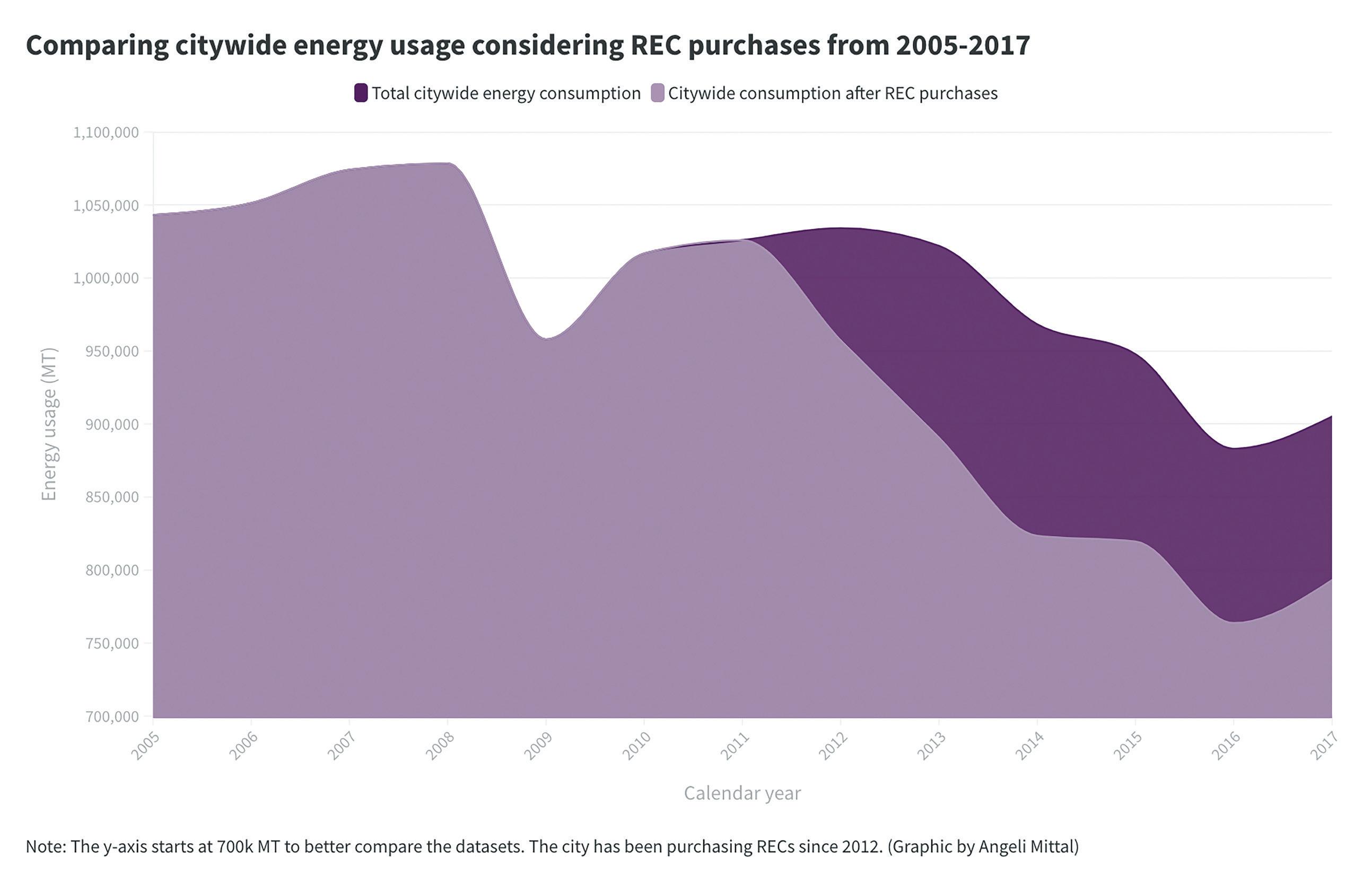
Evanston residents must join a “reservation list” to enroll in the program, according to MC Squared. Depending on project capacity, residents can wait from a week to a few months before con necting to community solar, according to Sharon Alegado, MC Squared’s manager of regional sales and community solar.
McFadden and Cotter are both subscribed to Evanston’s community solar program. They think it’s among the best alternatives to purchas ing RECs.
“Community solar is a really great (program) for residents who want to make an impact on climate, but also ensure that there’s demand for
clean energy that is built right here in Illinois, and also want to save money,” McFadden said.
Obstacles to outreach
A main barrier to the program’s growth is get ting the word out. Towns can’t sign residents up automatically for community solar like they can for electricity CCAs — community members have to voluntarily opt in to the program.
This means residents need some knowledge of community solar’s benefits. Providing this edu cation can be a challenge, according to Myriam Perez, the energy outreach coordinator and orga nizer for Rogers Park food justice group A Just Harvest.
“There’s been predatory sales based on (solar energy),” Perez said. “To build trust around that is very difficult.”
Evanston and ComEd have both warned resi dents to watch out for scammers, who often offer homeowners low-cost renewable energy deals in an attempt to steal their personal information.
Perez currently works as a grassroots educator, teaching residents about statewide solar incen tives as part of Illinois Solar for All. Created under FEJA, Solar for All provides savings and subsidies for low-income customers interested in commu nity solar or rooftop solar panels.
Residents in parts of Evanston’s 2nd, 5th and
8th wards qualify for income-based benefits under Solar For All. Non-income qualified residents can receive separate solar incentives through Illinois Shines.
These community solar incentives aim to make solar more accessible for renters and people who live in apartment complexes, so they don’t need solar panels on their roofs to participate, Perez said.
Evanston is also looking to implement its own Accessible Solar Program, which would help with rooftop solar panel installation costs, as one of its 2023 CARP action items.
Looking ahead, Nieuwsma said the city wants to find a way to aggregate residents on to community solar. He said combining the local energy source of community solar with aggregation would be a viable option, though it’s not legal yet.
As support grows for more direct methods of decarbonization, McFadden said the city can’t sit back and wait for the opportunity — it needs to take action.
“Advocates would need to hear from commu nities like Evanston that this is something that they would like to see changed,” she said. “If Evanston were to speak out, I think that would help the advocacy community to take note.”
lilycarey2025@u.northwestern.edu
MONDAY, NOVEMBER 21, 2022 THE DAILY NORTHWESTERN 5
A&E A&E
arts & entertainment
Musicians perform at SWAN’s Battle of the Bands
By BEATRICE VILLAFOR the daily northwestern @beaviilla
Three newly formed student bands per formed original songs and covers to raucous applause in Lutkin Hall on Friday at the Song writers Association at Northwestern’s first Battle of the Bands competition.
Bienen and Communication junior Anna Castagnaro, SWAN’s co-president, said the club planned the event throughout Fall Quarter.
“People who aren’t music majors or people who want to learn how to write songs or pro duce, they just don’t really have a space to do that physically and community-wise.” Cast agnaro said.
McCormick sophomore Ritvik Karra said giving these musicians a space was a motiva tion for hosting the event. As one of the coorganizers for Battle of the Bands, he said it was difficult to arrange practice spaces and instrument rentals during the planning process.
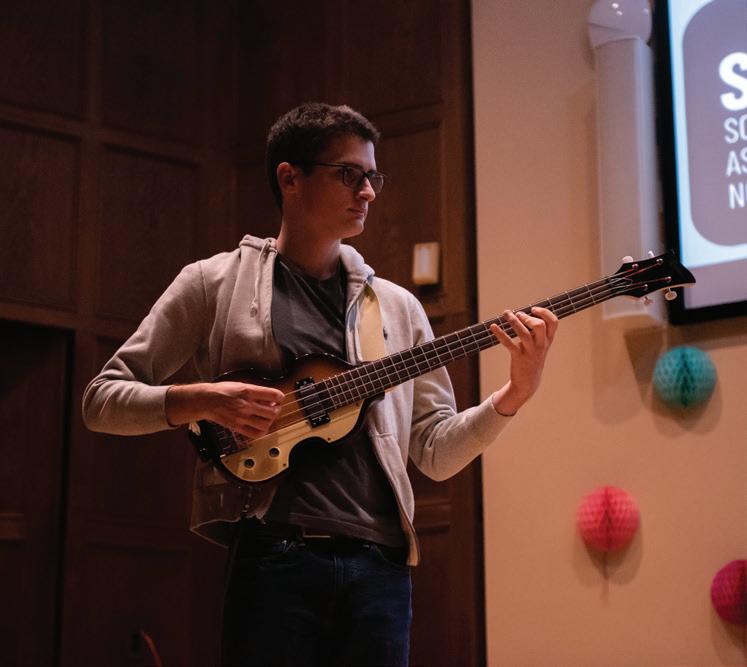
Karra is also the drummer for the band
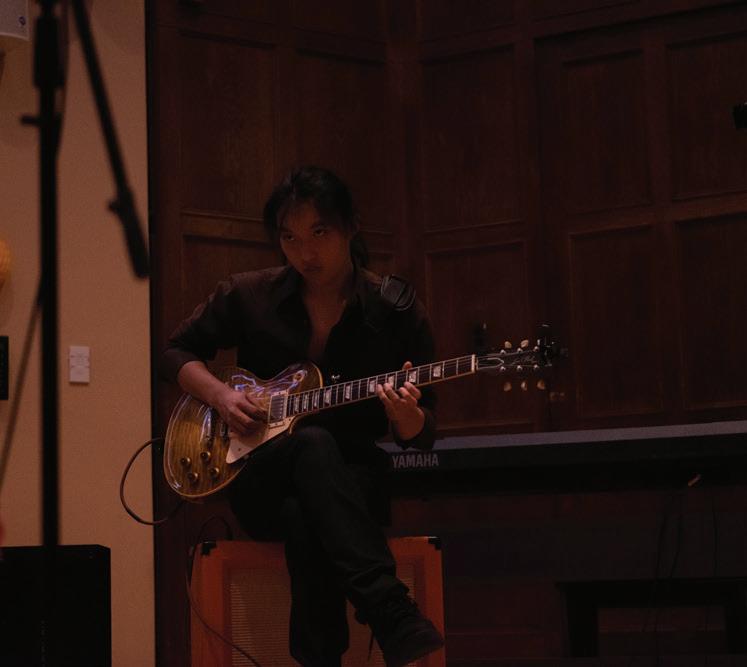
99%, which performed at the Friday event. He described the band as demographically “99% Desi and 1% Indonesian.”
99% kicked off its set with “Life is a High way” by Rascal Flatts. Weinberg sophomore and lead vocalist Samir Khatri’s belting rever berated to the back of the hall. The four band members’ chemistry was also palpable as they joked with the audience and each other.
“Are there any Chainsmokers fans in the house? Are there any chain-smokers?” Khatri quipped before launching into a medley of The Chainsmokers’ “Something Just Like This” and “Closer.”
During the set, 99% explored a range of musical styles, following “Under Cover of Darkness” by The Strokes with an understated cover of “Rude” by MAGIC!.
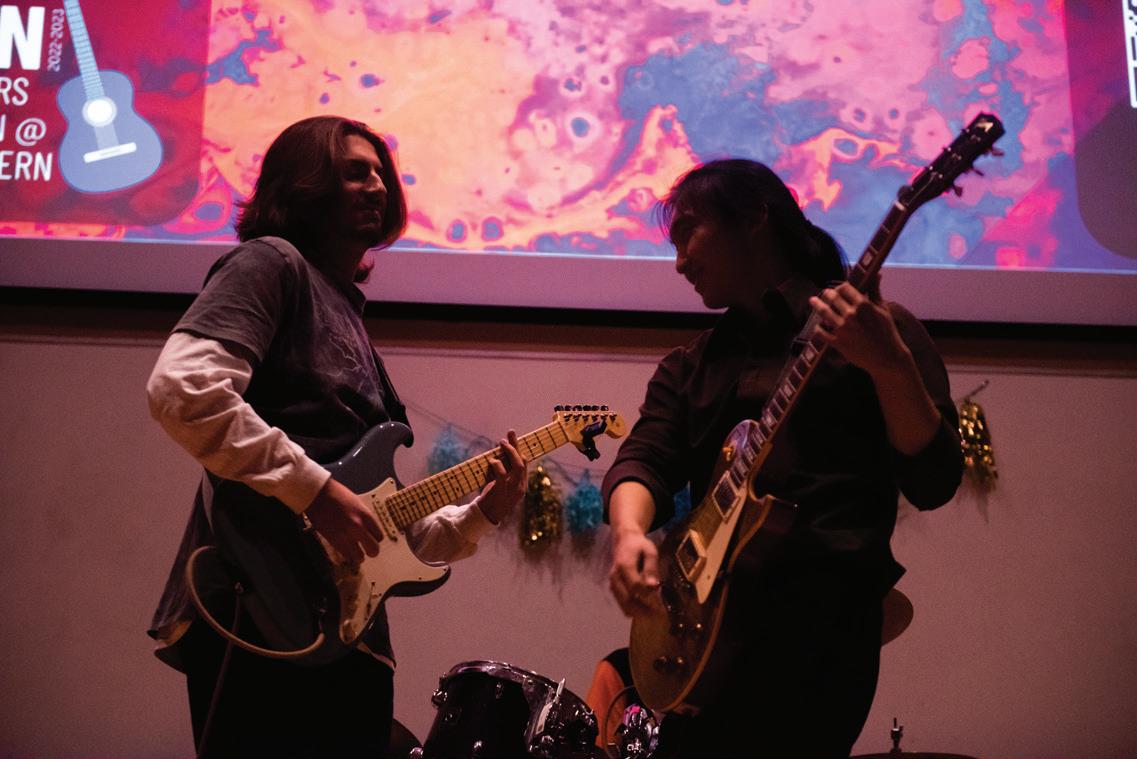
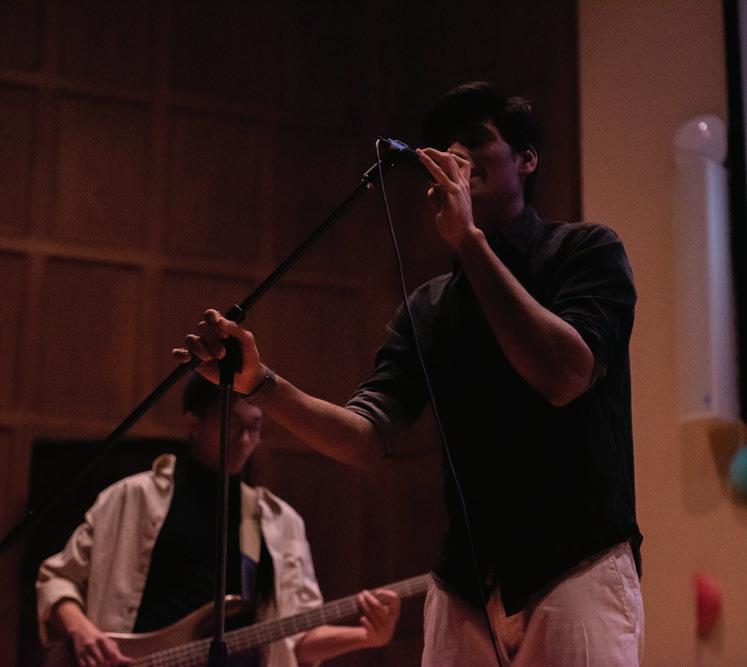
Moontide, helmed by Communication grad uate student Yilan Li, also performed at the battle. Li, who produced and wrote the band’s entire set, said her music is about “unfulfilled, missed and upcoming encounters.”
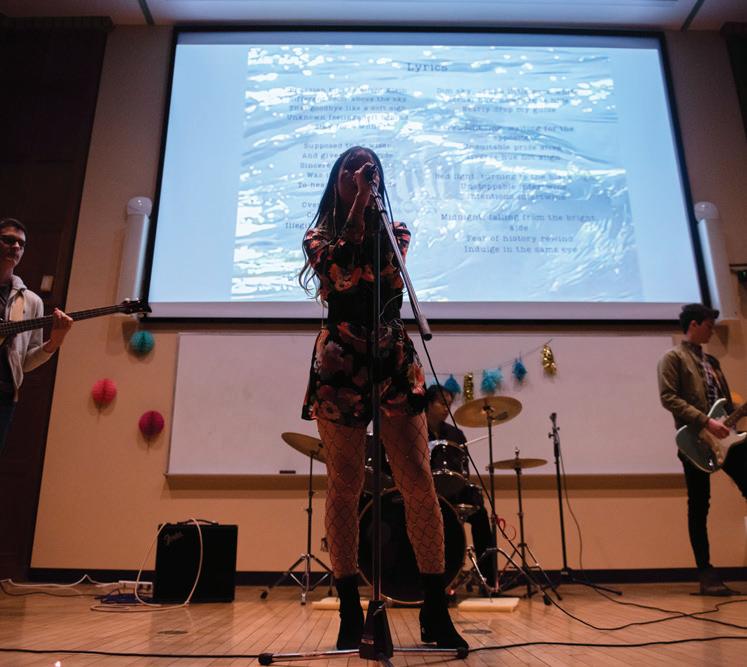
Li’s light, airy vocals contrasted the booming drums and bass lines of her bandmates during
their first song, “Different Hue.”
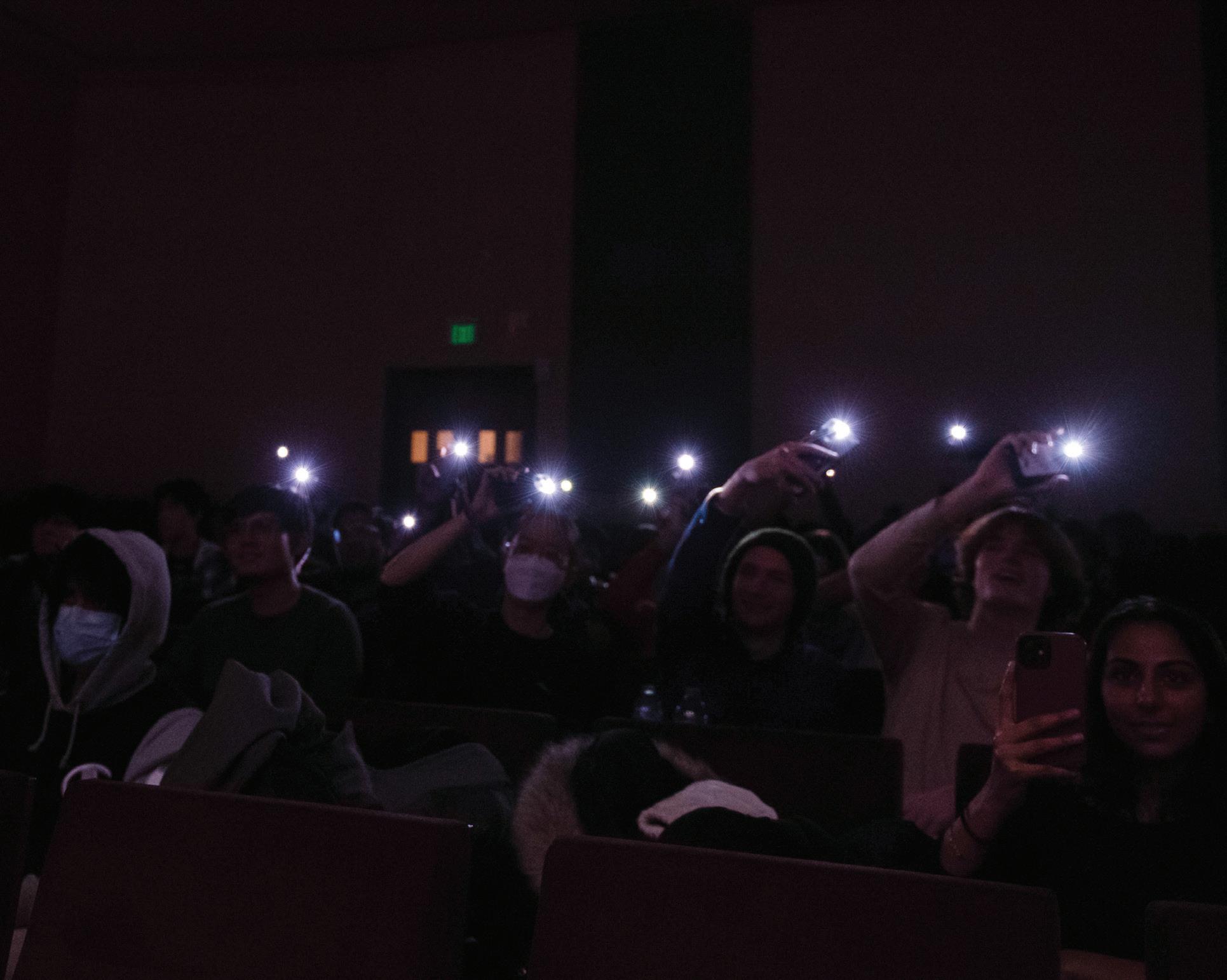
“Planet Klein” featured lyrics in Mandarin, Li’s first language, distinguishing it from other songs played throughout the evening.
Li said though she was worried audiences wouldn’t resonate with the song due to the lan guage barrier, her bandmates encouraged her to put “Planet Klein” in their set.
The ethereal calm of Moontide was con trasted by the piercing sound of Revere, the last band of the night.
Revere engaged the audience with an invita tion to mosh. Some audience members took their phones out to film, and others crowded the stage for “Bleed American” by Jimmy Eat World.
The band’s brooding set was rounded off with “Highway Star” by Deep Purple.
Audience members voted for their favor ite act and favorite musician throughout the performances.
After a tense wait, Revere emerged victori ous as the crowd pleaser. The band played an instrumental encore as audience members filed out to start their weekends.
“When I see the other two bands perform, I think that they are really talented,” Li said about her band’s loss. “(Moontide has) some space for improvement … (but) we totally enjoyed it.”
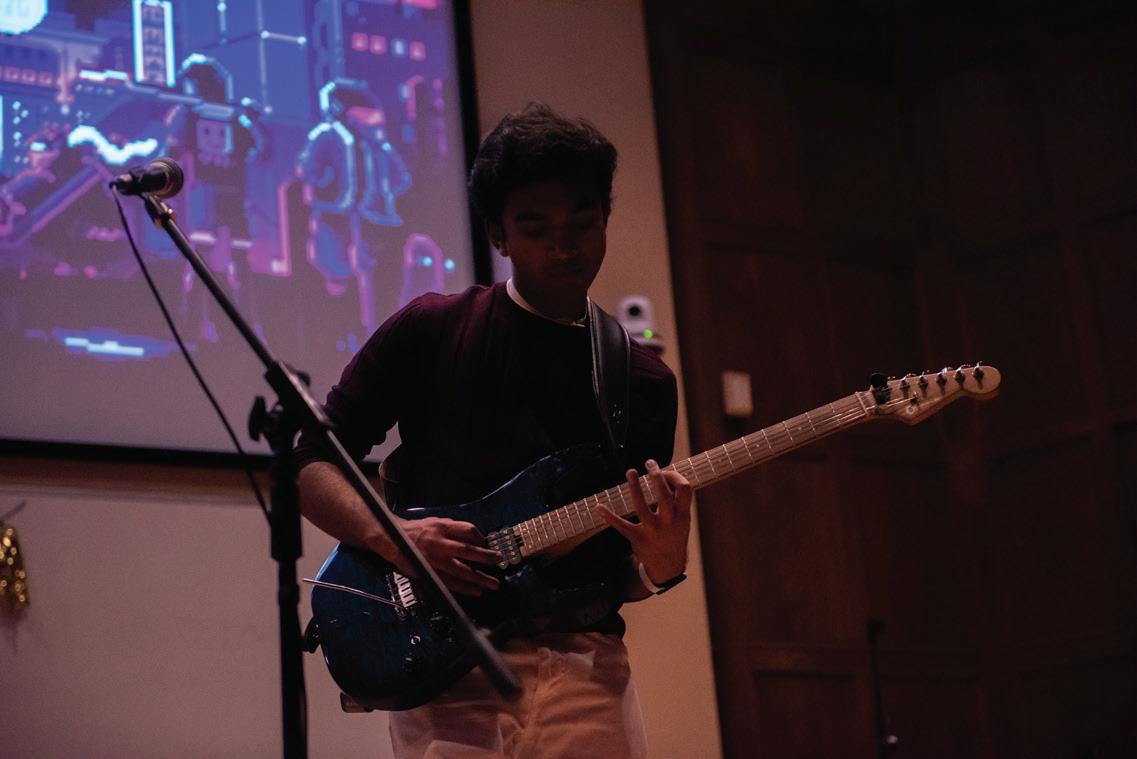
Similarly, Karra said the result of the com petition was secondary to the happiness he felt seeing the event come to fruition. To Karra, spaces like Battle of the Bands are invaluable to the music-making community at NU.
“I’m just happy that it happened,” Karra said. “The turnout was really good, people got excited, the bands were happy, the people watching the event were happy.”
Castagnaro also said hosting the event was important in empowering students to continue developing their craft.
She added that SWAN plans to host simi lar events to cultivate ensemble music beyond Battle of the Bands.
“I can see (band members’) faces light up when they’re able to write music.” Castagnaro said. “We get to see these ensembles come to life in a space that’s really theirs.”
beatricevillaflor2026@u.northwestern.edu
‘Spoiler Alert: Somebody Dies’ presents comedy-horror
By ELIZA MATTSON the daily northwestern @elizamattson1
Sit & Spin Productions premiered its interac tive comedy-horror experience “Spoiler Alert: Somebody Dies” this past weekend in Locy Hall — and spoiler alert: somebody died.
Set in a remote ski lodge, the play depicts eight college friends navigating their personal relationships as they solve the murder of their friend. An emcee also interrupted the action to interrogate characters and banter with the audience.
Communication junior Stephen Peng wrote and directed the play. After pitching his idea to Sit & Spin’s board, Peng said he received one of the board’s two yearly Artist in Residence slots to put on the play.
Peng said he began writing “Spoiler Alert” in his Introduction to Screenwriting class last
spring after having the spontaneous idea to put all of his friends in a dramatic murder mystery.
“When I was in my playwriting class, I was writing it as … a stage play, so there was no experimental part of it,” Peng said. “I was think ing, ‘This would be really cool if it’s immersive.’”
Though the play began in a classroom set as the lodge’s “living room,” actors walked all throughout Locy Hall during Friday and Sat urday’s stagings. Audience members split up to follow the characters they found most compel ling as the plot unfolded in classrooms, bath rooms, hallways, stairwells and even outside in the 20-degree weather.
Throughout the writing process, Peng said he couldn’t help but work in his two favorite genres: comedy and horror. He pulled inspira tion from the movies “Mean Girls,”“Halloween” and “Scream.”
Peng said both genres play with expectations, distance and relatability. When writing, he said he leaned into character tropes for comedic
effect, like the jock, the cheerleader and the religious girl.
“I split myself into nine different personalities and then put them onto character models that I invented from my friends,” Peng said.
Communication junior Max Reichek, the show’s producer and one of its actors, said rehearsals emphasized building chemistry between the actors.
“There was no formal casting,” Reichek said. “Everyone was invited individually.”
Reichek played Richard, a wealthy and ver bose student whose parents owned the lodge. He said he was also responsible for making the production run smoothly, including editing the script, ordering props and reserving classrooms.
Both Peng and Reichek said the production team played a key role in managing and trouble shooting problems that arose from the show’s experimental approach. For instance, Peng said all the light changes were programmed into a phone because the lighting designers did not
have access to a traditional light board. Actors took staging cues from the lights changing or flickering.
“We need to give more credit to designers because they work really, really hard, but they’re not the one’s that shine in front of the audience,” Peng said.
Peng, who is the diversity and inclusion chair of Sit & Spin, also said he prioritized assembling a diverse cast and production team.
Medill freshman Elizabeth Lowry said she felt captivated and immersed by the play.
“My body was sometimes wandering, some times sprinting, to catch up with the characters with so much liberty in their world and on their stage,” Lowry said.
Spoiler alert: Richard was the murderer. Whether or not audience members solved the mystery before the characters on stage was up to them.
MONDAY, NOVEMBER 21, 2022 6 THE DAILY NORTHWESTERN
elizamattson2026@u.northwestern.edu
Noyes’ exhibit explores personal and collective grief
By JACK AUSTIN daily senior staffer @jackaustinnews
When Connie Noyes lost her husband and father within 10 days of each other, art served as a crucial healing and coping mechanism. Noyes’ most recent exhibit, “we are built in water,” reflects on grief and the cycle of life and death. It is on display at the Evanston Art Center through Dec. 18.
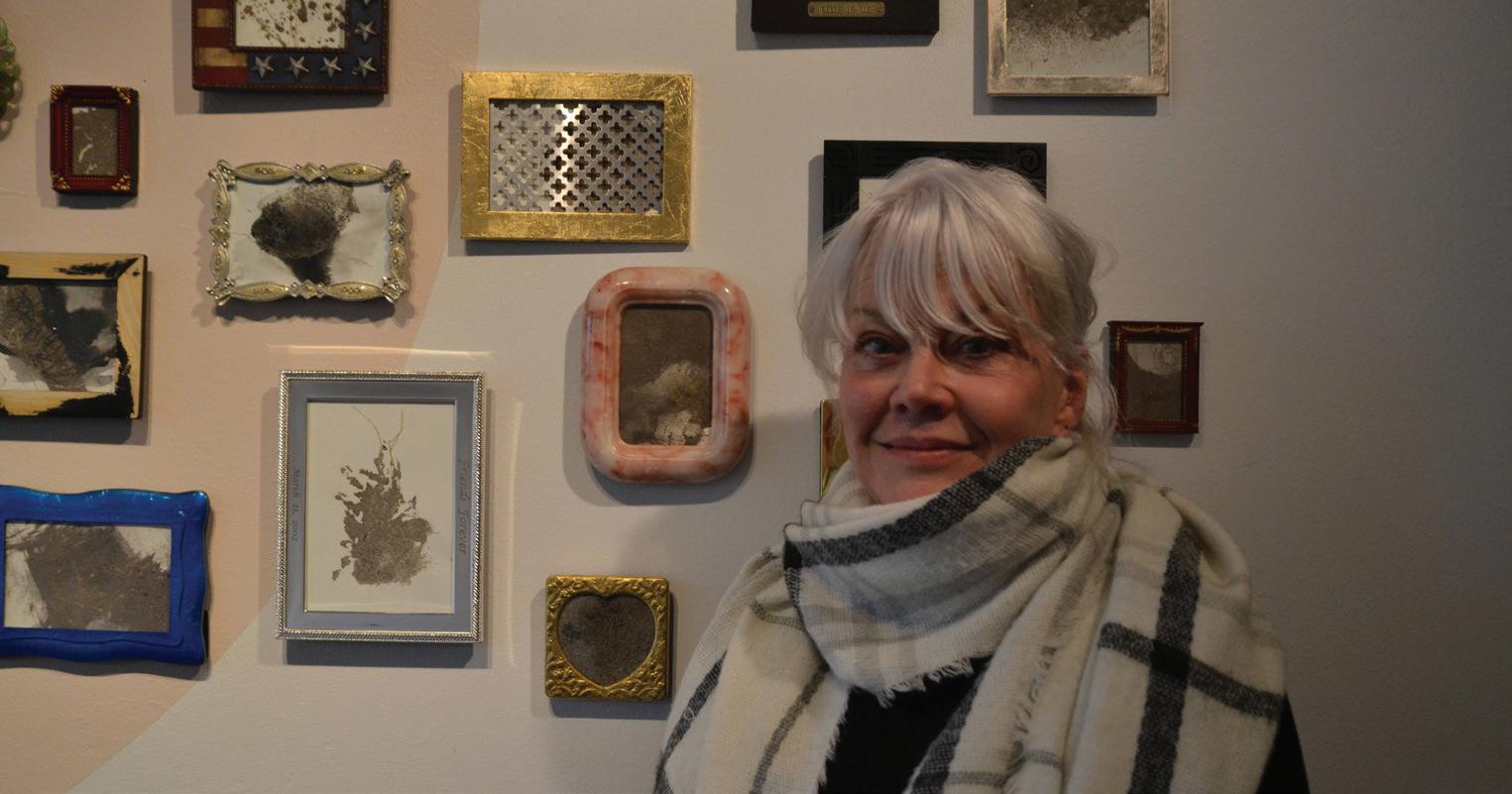
Themes of water thread through the abstract exhibit, which employs many mediums, including sculpture, video and ash painting. Noyes said along side her personal grieving process, the show also explores collective grief caused by the COVID-19 pandemic. Water is the metaphor for both birth and death, according to Noyes.
“The metaphor for birth is more obvious — we’re in this incubation in the mother’s water for nine months,” Noyes said. “When we come out and scream, it is, I believe, the first cry of grief. I see the ocean as a repository of tears from all the grief that has been shared over millennia.”
Audrey Avril, the manager of exhibitions at the Evanston Art Center, said Noyes’ multiple artistic mediums add to the visitor’s experience of emo tions. She said there is a kaleidoscope of different sensory introductions, like the waves crashing in a video playing on-screen in the exhibit and the visible patchwork of the suspended chair sculptures that enable visitors to experience grief at their own pace.
Avril said the exhibit depicts both small and large
moments of loss, allowing the art to resonate on different levels.
Peter Fleps, the director of developmental art venue Wedge Projects in Chicago, said he thinks Noyes’ show attempts to acknowledge healthy ways of grieving and continuing to live. He described Noyes as an explorer and battler in her artistry.
“The emphasis is not just on grief and death — it’s on life,” Fleps said. “A life that isn’t killed by grief but is not ignorant of grief.”
Grief is universal and has been intensified by the pandemic, according to Tricia Van Eck, the artis tic director at experimental nonprofit arts venue 6018North.
Van Eck said that in some way, everyone lost something during the pandemic — be it loved ones or a way of life. She added she thinks groups of friends or psychology classes would benefit greatly from seeing the show together and reflecting on common grief.
Van Eck said she thinks the exhibit is an invitation for people to sit with grief — something she thinks society does not often practice.
“By sitting with it, addressing it, perhaps we can acknowledge (grief’s) effects,” she said. “We can look at death as a continuum rather than an end.”.
The show includes materials connected to the sea, such as dried seaweed. Noyes’ son, a diver in San Francisco, collected many of the artistic materials.
Noyes said the ocean adds another layer of grief because of the detriments of environmental stressors like pollution, overfishing and endangered species.
According to Fleps, Noyes carefully chooses her
materials to satisfy her personal inclinations and resonate with the audience. He said he thinks the show combats the notion that grief has to kill the griever.
Fran Joy, an artist on the Evanston Art Center’s Exhibition Committee, said she thinks the exhibit is unique and unusual due to the variety of materials and the wide use of the color white. Joy said she was impressed the show tackled such a complex, difficult personal experience, especially since many people
don’t know how to deal with loss or trauma. This expression of grief through art can help other people navigate their own feelings, Joy said.
For Noyes, grief is a manifestation of love.
“I have come to the conclusion that grief is love, and grief is praise,” Noyes said. “You cannot pos sibly grieve and feel the things that you feel, those complicated emotions of grief, without love.”
jonathanaustin2023@u.northwestern.edu
‘In the Heights’ cast celebrates identity through musical
By SCOTT HWANG the daily northwestern
The original “In the Heights” musical on Broadway hardly lacked pizzazz, if four Tonys and 13 nominations count for anything. But North western’s upcoming production of the show seeks to add even more flair.
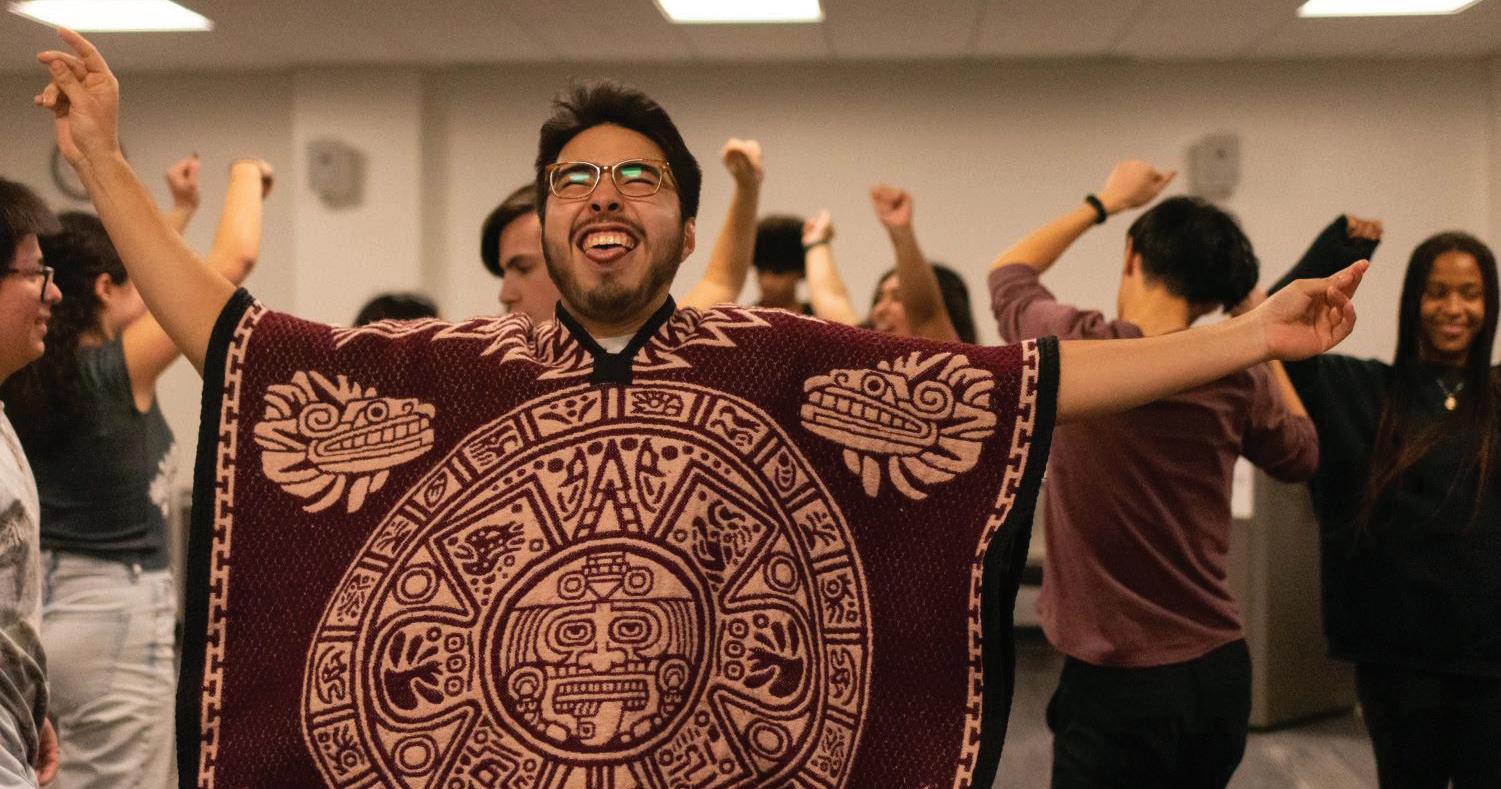
NU Arts Alliance’s production of the musi cal written by Lin-Manuel Miranda and Quiara Alegría Hudes will run Dec. 1 to 3 in McCormick Auditorium.
“In the Heights” tells the story of a Latine and immigrant community in Washington Heights, New York City over the course of three days.
Communication junior and director Alondra Rios said she plans to immerse the audience in the story’s universe.
“Usually when you go into a theater, you sit and you wait for the show to start,” Rios said. “We want the audience to be halfway there before the show even starts.”
She also spoke about immersing the audience in the show with a variety of sensory elements, from the smells of home cooking to the touch of different fabrics. She said the production uses the whole theater as a stage.
Communication senior Gabriela Furtado Coutinho said these sensory details remind her
character, Abuela Claudia, of her native Cuba.
“This might be the first time I as a performer get to tell an immigrant story on stage, and I am an immigrant,” Furtado Coutinho said. “This is sacred work that connects us to our roots and stories, the core of who we are.”
Like Furtado Coutinho, Bienen senior David Garcia Suarez said playing the character Usnavi resonates with his personal experiences.
Garcia Suarez’s parents are immigrants, and for much of the show, Usnavi dreams about returning to his home in the Dominican Republic.
“I definitely find that there’s a lot of overlap between his circumstances and mine, us both having a very strong connection to home,” Garcia Suarez said. “I haven’t been back to Mexico since I was two years old, and that’s always something I’ve wanted to do.”
Communication sophomore Arwen-Vira Marsh said playing Nina Rosario, a first-generation col lege student, helped her process being the first person on her mom’s side to go to college.
As a Black actor, Marsh also said their identity brings a slightly different story to the role, which is not often played by a Black actor.
“There’s a moment between me and my love interest Benny at the end of Act One that is really, really beautiful,” Marsh said. “Benny is played by a Black man … We rarely get to see a Black love story on stage.”
Furtado Coutinho and Rios said the song “Car naval del Barrio” is one of their favorite moments. During the song, Washington Heights community members respond to sudden local changes by rais ing the flags of their home countries.
Rios said this scene provides a chance to honor the different immigrant stories of the cast. Mem bers fly flags from their own places of origin, such
as Venezuela and Hong Kong, in addition to those of their characters.
Rios hopes that audiences will connect — and join in — with the show.
“Be prepared to laugh, to cry and to dance,” she said.
scotthwang2026@u.northwestern.edu
NU Opera Theater hosts Midwest premiere of ‘In a Grove’
By JAMIE KIM daily senior staffer
A missing botanist and an apparently murdered schoolteacher. Seven witnesses, suspects among them.
A mysterious tale awaits audiences of “In a Grove,” an opera by Christopher Cerrone with a libretto by Stephanie Fleischmann, which will make its Midwest premiere in the Ryan Opera Theater on Thursday. The opera is presented by the Northwestern University Opera Theater at the Henry and Leigh Bienen School of Music and includes members of the Contemporary Music Ensemble.
Set in 1921 Oregon, the production is based on a short story of the same name by Ryūnosuke Akutagawa. In the performance, various characters give their testimonies of what they know about the botanist, schoolteacher and outlaw. The show is dou ble cast, meaning two separate casts will alternate performances.
Bienen and Communication freshman Casey Lyons, who will play the priest, said he is working to use his words as a vessel to create imagery and share that scene during the priest’s interrogation.
Lyons said the music is a defining factor of opera, differentiating it from other forms of theatre. A per former doesn’t only consider the text but also how to connect their character’s thoughts with the music, he said.
“When you sing it, there is just such an emotional difference and a special way that the writers get to specifically craft the way they think of this character,
and then you get to infuse the way you think of this character,” Lyons said.
Bienen first-year master’s student Lifan Deng portrays a policeman who is emphatic about having been the one to capture the outlaw. There is a tense interaction between his character and the agents inter viewing the witnesses.
Deng said the structure of the performance as a series of testimonies and the incorporation of elec tronic music make the opera unique and modern.
Conductor Alan Pierson said the story and theatre are on the border between the abstract and that the realistic and the melody, harmony and rhythm are both “remarkably simple” and detailed.
The performance involves technical aspects such as projections and shadow imagery. While opera singers do not typically perform with microphones, singers in the upcoming performance will have microphones for electronic modifications.
Pierson added that when the players and singers perform together with the electronic modifications, the elements merge into something that is “way more than the sum of the parts.”
“There’s this beautiful simplicity to it and a kind of magic that emerges when everything is put together,” Pierson said.
To open “In a Grove,” the players will also perform “Hands,” a collection of pieces written by composer François Sarhan that tells stories of immigrants and manual laborers. Pierson said the two works are linked by the themes of responsibility and blame.
Pierson said in some ways, the details of the mur der are not in question, but the opera investigates
more subtle questions about responsibility.
“(Director) Joachim (Schamberger) and the actors go deeper and deeper into these questions and bring that understanding to bear on the performance that they’re creating, which has come to be a really emo tionally rich and compelling realization of these char acters,” Pierson said.
Bienen and Weinberg freshman Daniel Uglunts also portrays the policeman. He said the policeman, along with the priest and woodcutter, describes the scene before the audience sees the event itself.
As tension builds between the policeman and the agents, they move to the center of the stage and the policeman cuts through the tension with his final lines.
Isobel Anthony, a Bienen second-year master’s student, portrays Leona. Anthony said she starts from her own “kernel of truth,” depending on where she is in a given moment, and then brings Leona into her psyche.
While Leona comes out differently each night, she is consistently brave and strong.
“She’s always firm in what she thinks, she asks for what she wants,” Anthony said. “When tragedy hits, she doesn’t just crumple under the weight of that bur den — she rises to the challenge of making it right.”
Anthony said she is excited to “dive into” the acting aspect of the opera and engage with the audience. She said the opera is a “philosophically interesting” piece that explores different layers of guilt.
Deng said he is passionate about contemporary opera so he is excited to debut at NU in the style.
“I am so grateful that I can be in this cast and I
jamiekim2025@u.northwestern.edu
arts & entertainment
MONDAY, NOVEMBER 21, 2022 THE DAILY NORTHWESTERN 7
get to work with so many amazing people along this journey, and I can’t wait to see how this production will turn out this weekend,” he said.
Editor Kara Peeler Assistant Editors Ashton Goren Jenna Wang Designer Wendy Zhu Sara Gronich Staff Beatrice Villaflor Eliza Mattson Jack Austin Scott Hwang Jamie Kim
Lexi Goldstein/The Daily Northwestern “In the Heights” director Alondra Rios described the show as a “celebration.”
Jack Austin/Daily Senior Staffer
The artist stands in front of framed ash paintings threaded with gold. “we are built in water” explores grief and the cycles of life and death.
OPINION
Mwangi: George R.R. Martin supports creative writing
DUNCAN MWANGI OP-ED CONTRIBUTOR
Word on the street is, George R.R. Martin, one of Northwestern’s most renowned alumni, is back at Northwestern and he’s feeling generous enough to donate a creative writing professor to NU. Or maybe he’s donating to a creative writing profes sor at NU. Either way, a chair is involved.
I snagged a spot at the Nov. 10 luncheon in Scott Hall, one of three appearances Martin made on campus, by posing as a recent con vert of HBO’s “House of the Dragon.” Given my ridiculous attention span and a longstanding hate affair with fantasy (because of said atten tion span), nothing could’ve been further from the truth.
experience bundled up with a lot of roommates in Uptown and his extensive career writing sci-fi and fantasy literature and screenplays — it felt like an anointing of sorts.
My time in the NU creative writing program has rekindled the feeling of art in bringing people together. When COVID-19 hit in 2020, I was in my first-ever writing class, taught by the talented 2018 Caine Prize Winner Makena Onjerika. I connected with fellow budding writers from all over Nairobi. Together, we imagined scaling the heights of publishing and getting our works adapted on the big screen, despite having undergone an education system that delegitimizes creative writing as a career.
Then we transitioned to Zoom calls, and the dimensions of our contact changed.
classes are the only classes where I receive unso licited reassurance about my career and financial prospects. The idea that all of us can fill our pockets if we choose to lead this life seems almost alien. All my writing mentors, from Onjerika to my current NU professors, harp on the material implications of a creative writing career.
Even Martin, who drew so much wisdom from his writing heydays (in addition to donating a chair), took the time to impress on us the value of the dollar. It’s not a needless concern. The precari ous nature of traditional jobs for creative writing majors outside academia means we’re not some cogs that will easily fit into the system. Therefore, it makes sense that the underlying premise for most of Martin’s advice is: don’t go broke chasing your dream.
I end up writing for a Marvel movie or a personal blog — I have a feeling my passion for writing is here to stay. It can be a little jarring to realize that I will never have the same distance between me and my work as most of my corporate peers will. Like them, I’ll need to start at the bottom and then work my way up, but never with the same kind of flexibility. If I commit to writing, there’s a chance I’m stuck with it for life. It wouldn’t be a bad life, despite the wily ways of the publishing industry — how they’ve aggressively marketed seminal queer and Black works in the past by emphasizing the identities of the authors.
Anyway, I am not above making money.
-
Martin was there in all black, flanked by his assistant of nine years and two NU professors tinkering with sound and television media. I learned the alumnus is donat ing $5 million to the Medill School of Journalism, Media, Integrated Marketing Communications in the service of storytelling, establishing a cre ative writing summer program and an endowed professorship.
Listening to him speak about his voice and media influences, interviews with activists and
WAHIB CHARAMAND
OP-ED CONTRIBUTOR
Sharp edges. Ceramic bezel. Sapphire glass. Intricate blue dial. Blue subdials. Subtle sweep second hand. Open back exposing intricate caliber. Titanium bracelet.
— BEIRUT LOCAL TIME —
Sept. 3, 2008, 3:54 p.m. I was five years old. I found myself no longer on the playground, but staring at the ceiling of a speeding ambulance, remembering only that instant I toppled from the monkey bars. My vision was blurry, but I recognized my mother by my side, her cries piercing my ears. Then, darkness. As I lay in my hospital bed days later, I noticed my grandfa ther slip a cold solid mechanism into my hands, admiring its gentle glisten contrast against the harsh ultraviolet light. It was his treasured pocket watch, purchased at the Khan El-Khalili souk on his 1973 trip to Cairo. He had been inseparable from his watch for nearly 35 years.
May 27, 2018, 9:37 a.m. I rediscovered the watch 10 years later while packing for my
My first writing class at NU was a poetry class with Prof. Susannah Young-ah Gottlieb in Fisk Hall. I was living a nightmare — three classes in a row every morning. Poetry was usually something I was good at deciphering, but only through a formal process I had developed in my high school literature classes. It was refreshing to see her make a game out of every lesson. Despite dropping the class early in the quarter, it encouraged me to seek out more creative writing classes. A few resolutions down the line, I am a proud creative writing minor.
I am well aware of the fact that creative writing is deemed unviable by many social, scientific and political institutions of our time. Creative writing
Martin’s mainstay genres, sci-fi and fantasy, rake in the bigger bucks. They bring writing much closer to the technological and futuristic ambitions that society is obsessed with today.
There’s no doubt Mar tin’s mainstay genres, scifi and fantasy, rake in the bigger bucks. They bring writing much closer to the technological and futuristic ambitions that society is obsessed with today — metaphysical ambitions, design ambi tions, ambitions regard ing diversity, the doomsday clock. They also seem to draw out most of the money from other cultural institutions like film and fashion. They attract audiences across ages, races and socioeconomic backgrounds compared to other creative writing genres. Other genres can only bear glimpses of such success.
- DUNCAN MWANGI, Op-Ed Contributor
George R.R. Mar tin’s donation chiefly targets journalists who want to be cre ative writers, just like him and me. It aims to teach writers skills across fiction and film. All I can ask of NU’s creative writing program is to leave room for writers who are curious, suspi cious and who look at everything with double intent — writ ers who question everything, even the publishing game they’re committing their lives to.
There’s the feeling of pride that comes with exploring all genres of writing, whether or not they end up being my mainstay. It doesn’t matter if
Duncan Mwangi is a Medill junior. He can be con tacted at duncohmwangi2024@u.northwestern.edu. If you would like to respond publicly to this op-ed, send a Letter to the Editor to opinion@dailynorth western.com. The views expressed in this piece do not necessarily reflect the views of all staff members of The Daily Northwestern.
to emulate.
family’s move to our new home. I viewed it with newfound appreciation — as more than a simple “get well soon” gift. I was intrigued; it ignited in me a curiosity and respect for timepieces.
From there, my passion for watches was born. I delved deep into research, studying the development of the modern chronograph and the evolution of automatic watches into quartz watches. I dissected the caliber of a watch and analyzed the mechanics: the way the rotor supplies a watch’s mechanical energy by winding the mainspring, or how each position of the crown can have a completely different use like winding the watch or changing its date or time. I came to understand how the escapement of a watch ensures its precision and learned to appreciate its technical complexity and elegant fluidity.
Glass shards littered the floors and blinding clouds of dust filled the room. I desperately tried to feel my way around the walls to find my father. Time stopped. Everything froze. The concept of time dawned on me. To me, time had always been a quantitative entity, constantly increasing in value. But time was no longer objective, organized and absolute.
It became subjec tive, chaotic and undefined. These few seconds changed my life.
Time is infinite. I realize now that the true value of a watch comes from its original pur pose and its steward. It is not a reflection of its components but of its functionality and its owner. A watch is a timekeeper, a reminder of the memories and events that have shaped one’s life.
-
Aug. 4, 2020, 6:07 p.m. The largest non-nuclear explosion in history rocked the capital’s port. The house was a wreck.
Before this devas tating event, I thought a watch’s value was defined only by the quality of its compo nents, reflecting the personal worth of the individual. Sharp edges and a ceramic bezel symbolize strength under pres sure; sapphire-coated glass, class and elegance. A blue dial means creativity and limitless pos sibilities; the titanium bracelet, resilience; and an exposed caliber symbolizes candor and transparency. I thought if I were a watch, that would be the type of watch I’d want to be because those were the characteristics I aspire
The Daily Northwestern Volume 144, Issue 18
If I were a watch, I would want to be the watch passed down from one generation to the next as a proud reflection of my life and legacy. I would want to be the watch that survives the hardships of a country repeatedly shattered by crises. I would want to be the watch that instills the hope that Helen Keller once said, “sees the invisible, feels the intangible and achieves the impossible.” I would want to be the watch that carries the wisdom of the past and the vision of the future. Most importantly, I would want to be the watch that endlessly inspires future generations to be their own watches. A timeless piece.
Wahib Charamand is a McCormick School of Engineering sophomore. He can be contacted at wahibcharamand2025@u.northwestern.edu. If you would like to respond publicly to this op-ed, send a Letter to the Editor to opinion@dailynorthwestern. com. The views expressed in this piece do not neces sarily reflect the views of all staff members of The Daily Northwestern.
LETTERS TO THE EDITOR may be sent to 1999 Campus Drive, Evanston, IL 60208, via fax at 847-491-9905, via e-mail to opinion@dailynorthwestern.com or by dropping a letter in the box outside The Daily office.
Letters have the following requirements:
• Should be typed
• Should be double-spaced
• Should include the author’s name, signature, school, class and phone number.
• Should be fewer than 300 words
They will be checked for authenticity and may be edited for length, clarity, style and grammar.
Letters, columns and cartoons contain the opinion of the authors, not Students Publishing Co. Inc. Submissions signed by more than three people must include at least one and no more than three names designated to represent the group.
Editorials reflect the majority opinion of The Daily’s student editorial board and not the opinions of either Northwestern University or Students Publishing Co. Inc.
Join the online conversation at www.dailynorthwestern.com
MONDAY, NOVEMBER 21, 2022 8 THE DAILY NORTHWESTERN
I would want to be the watch that endlessly inspires future generations to be their own watches. A timeless piece.
WAHIB CHARAMAND, Op-Ed Contributor
”
All I can ask of NU’s creative writing program is to leave room for writers who are curi ous, suspicious and who look at everything with double intent — writers who question everything, even the publishing game they’re committing their lives to.
DUNCAN MWANGI, Op-Ed Contributor
”
Editor in Chief Jacob Fulton
Managing Editors Isabel Funk Angeli Mittal Maia Pandey Jorja Siemons
Opinion Editor Kadin Mills
Assistant Opinion Editor Colin Crawford
”
Charamand: A timepiece that means so much more
Northwestern works to increase bathroom equity
By KAAVYA BUTANEY the daily northwestern @kaavya_butaney
Northwestern community members have been advocating for gender and menstrual equity in campus bathrooms for years. Some of these campaigns are starting to see results this year, as students and faculty are collabo rating with the University to bring these goals to fruition.
Menstrual equity
In November, Residential Services com pleted the installation of menstrual product dispensers in 70 bathrooms across 30 residen tial buildings, according to Residential Services Director of Operations and Services Jennifer Douglas. The initial cost for installation was about $8,500.
The dispensers were installed in commonspace bathrooms and in all-gender bathrooms to ensure all people who menstruate can access them.
Last year, former Menstrual Equity Activists Director of Advocacy and first-year Feinberg student Rwan Ibrahim (Weinberg ’22) spear headed the “Menstrual Products in Dorms” project that requested menstrual products in all residence hall bathrooms.
MEA sent out a survey about menstrual products to the student body last winter, which received 662 responses. Of those surveyed, 99.2% said it would be helpful to have access to menstrual products in residence halls. While most of the installed bathroom dispensers have tampons and not pads, 79.5% of students sur veyed said they would like pads, compared to 66% who said they would want tampons.
MEA Director of Public Relations and Wein berg junior Ruba Memon said some students must pick between purchasing menstrual prod ucts and affording a meal. Ibrahim added that period poverty is an issue among students.
“An institution like Northwestern should be responsible for catering to (menstrual) needs, especially in dorms — places people consider homes on campus,” Ibrahim said.
She said these installations are just a first step, and Douglas said Residential Services will gauge student response to inform a possible expansion of menstrual product dispensers.

Currently, Memon is spreading the word about menstrual products in bathrooms with Residential Services through social media, emails and stickers.
“Menstrual products should be like toilet paper,” Women’s Center Director Sarah Brown said. “They should be in every restroom.”
Most of the work around menstrual equity has been student-led, according to Brown. Douglas said MEA made the first formalized request for menstrual services.
All-gender restrooms
Brown said she thinks facilities cleared four
new all-gender restrooms to be built, including one in Annie May Swift Hall. The locations are chosen for quick installation and distance from current all-gender bathrooms, Brown said. “It finally feels like there’s some momentum going,” Communication third-year Ph.D. stu dent Nathan Lamp said.
What complicates the construction of allgender restrooms is the Illinois plumbing code, Brown added. All-gender restrooms do not count toward the number of restrooms a building requires, according to the code. A bill changing this policy is currently in the Illinois Senate but until it is passed, there is less of an incentive to build all-gender restrooms.
Brown and Assistant Provost for Diversity and Inclusion Michelle Manno are working on centralizing a system to install these rest rooms. Facilities and departments are currently
splitting funding for these bathrooms, which Lamp approximates each cost $80,000. Accord ing to Multicultural Student Affairs Assistant Director Matthew Abtahi, this policy makes it hard for smaller departments to have all-gender restrooms.
Departments without all-gender restrooms find it difficult to recruit transgender and non binary students or faculty to work for them, Abtahi said. They called the current situation an “inequitable Band-Aid solution.”
“The University banks on student exhaus tion when it comes to protests,” Abtahi said. “It was pre-COVID that students were protesting at the bathrooms, they were having town halls with deans to try to go school by school (to advocate).”
These discussions, Lamp said, have been going on since they first arrived at NU in 2012.
In September 2019, the Gender-Queer, NonBinary and Trans Task Force released a report detailing how the University should support trans students, including a centralized identity management system. Abtahi said some students criticized the fact that the group, comprised of students, faculty, staff and alumni, did hun dreds of thousands of dollars worth of consult ing work for the University out of care for the issue rather than being compensated. The task force also released a report in 2015, Lamp said.
“It seems like (the University) just stuck it in a desk,” Lamp said. “There wasn’t a lot of traction for several years.”
Brown hopes to create a new metric for allgender restrooms. Rather than using the num ber of bathrooms as the principal measurement, she wants to know what percentage of buildings have an all-gender restroom or how many bath rooms there are per building capacity. Manno hopes each NU building will eventually have at least one all-gender restroom, per the task force’s recommendation.
Lamp said she is optimistic about the new University administration making a significant difference.
“It’s not a new thing,” Lamp said. “Students have been asking for this for some time … The work is ongoing and it continues even still.”
kaavyabutaney2026@u.northwestern.edu
MONDAY, NOVEMBER 21, 2022 THE DAILY NORTHWESTERN 9
Madison Bratley/The Daily Northwestern
The Daily Northwestern Fall 2022 | An independent voice since 1923 | Evanston, Illinois EDITOR IN CHIEF | Jacob Fulton PRINT MANAGING EDITORS | Isabel Funk, Maia Pandey, Jorja Siemons DIGITAL MANAGING EDITOR | Angeli Mittal DIVERSITY & INCLUSION CHAIRS | Joanne Haner, Katrina Pham SOCIAL MEDIA EDITOR | Nicole Markus AUDIENCE ENGAGEMENT EDITOR | Iris Swarthout NEWSLETTER EDITOR | Lily Carey CAMPUS EDITOR | Russell Leung ASSISTANT EDITORS | Pavan Acharya, Charlotte Ehrlich, Davis Giangiulio CITY EDITOR | Avani Kalra ASSISTANT EDITORS | Selena Kuznikov, Saul Pink, Laura Simmons OPINION EDITOR | Kadin Mills ASSISTANT EDITOR | Colin Crawford SPORTS EDITOR | Charlotte Varnes ASSISTANT EDITORS | Alex Cervantes, Kate Walter GAMEDAY EDITOR | John Riker PHOTO EDITOR | Jonah Elkowitz SPORTS PHOTO EDITOR | Seeger Gray ASSISTANT EDITORS | Madison Bratley, Esther Lim A&E EDITOR | Kara Peeler ASSISTANT EDITORS | Ashton Goren, Jenna Wang ILLUSTRATIONS EDITOR | Olivia Abeyta ASSISTANT EDITORS | Gemma DeCetra, Eliana Storkamp DESIGN EDITORS | Sara Gronich, Wendy Zhu ASSISTANT EDITORS | Joanna Hou, Anna Souter DEVELOPMENT AND RECRUITMENT EDITORS | Aviva Bechky, Mika Ellison, Alex Perry AUDIO EDITOR | Lawrence Price ASSISTANT EDITOR | Erica Schmitt VIDEO EDITOR | Olatunji Osho-Williams ASSISTANT EDITOR | Joanne Haner COPY CHIEF | Elena Hubert COPY EDITORS | Ella Je ries, Fiona Roach, Clare Zhang IN FOCUS EDITORS | Ilana Arougheti, Maia Spoto GENERAL MANAGER | Stacia Campbell SHOP MANAGER | Chris Widman BUSINESS OFFICE STAFF Minjee Jung, Will Kosann, Julia Narvaez Munguia, Branden Chen ADVERTISING PRODUCTION STAFF Sama Ben Amer, Molly Burke, Seeger Gray, Sammi Li
NU has been expanding bathroom equity with menstrual products in more residence hall bathrooms and more all-gender bathrooms.
From
the save. But on their fourth attempt, Carolina pulled out another set piece, with Sietske Brüning finding Ryleigh Heck, who deflected the ball past Skubisz.
In the second half, NU began to generate more offensive opportunities, playing more in the neutral zone. The Cats limited the Tar Heels to just three shots in the third quarter and two in the fourth.
Fifth-year defender Kayla Blas said the team improved on “attacking with strength” in the sec ond half.
“I think we really changed and were more strong on the ball,” Blas said. “We were getting into the circle, maybe not ripping shots but hoping to maybe hit a foot, get a corner or any type of opportunity that we could have gotten.”
After Blas spoke post-game, Fuchs said Blas’ mature attitude was why she is “one of the best leaders Northwestern field hockey has ever seen.”
For many of NU’s senior players, like Blas, this was their final game in a Cats uniform. Their time at NU saw them win the program’s first national title and make another national title game.
Before last season, NU’s last Final Four appear ance came in 1994. This season also marked consec utive finals appearances for the first time in program history. Despite the disappointing loss to the Tar Heels, the seniors have cemented their place in NU field hockey lore as some of the greatest players in the history of the program.
“It’s a really unique and really special thing to be able to compete in a Final Four and especially in a national championship,” Blas said. “It was something that (Skubisz) told me when she came on her visit four years ago, and that I chuckled at, but slowly it turned into a reality once that class got here … It’s going to have a special place in my heart, even if the outcome isn’t what we necessarily wanted.”
gabycarroll2023@u.northwestern.edu
SOLR MARCH
From page 1
SOLR member and Ph.D. student Gabriel said.
On Nov. 15, SOLR released a petition demanding the University reinstate access to free meals for maintenance staff, lengthen break times and designate a spot for them to eat and take breaks. As of Sunday night, the petition had more than 1,000 signatures.
The petition also noted that NU’s weekly food waste is 3.6 tons. SOLR asked the Uni versity to reevaluate why some of this food was not going toward feeding the maintenance staff.
“Time and time again, Northwestern Uni versity and its subcontractors have demon strated how little they actually care about the campus workers who make this university function,” the petition said. “The maintenance staff keeps campus buildings clean and livable,
yet Northwestern University and Compass Group deny them access to dining halls, a blatant cruelty which we strongly condemn.”
SOLR also called on NU to equip break spaces for maintenance workers with sinks, refrigerators and microwaves. The demands also included longer break times so mainte nance staff have the necessary amount of time to eat.
After delivering the petition, SOLR asked that Residential Services respond before Thanksgiving break begins Wednesday so maintenance staff regain access to free dining hall food as soon as possible.
“It’s as of this week that managers have stopped letting that happen, so this doesn’t seem like something that needs a lot of bureau cratic fixes,” Legallet said. “I would hope that it’s resolved quickly.”
nicolemarkus2025@u.northwestern.edu
Evanston’s CPRC tries to find footing in rocky terrain
By SAUL PINK daily senior staffer @saullpink
When Juneitha Shambee applied to join Evan ston’s new Citizen Police Review Commission in 2020, she wanted to address community members’ growing mistrust in police departments –– an issue that sparked national protests after the murders of George Floyd and Breonna Taylor by police.
“I initially believed that because we were creating this commission, people will see that Evanston is doing some thing right,” said Shambee, a criminal defense lawyer.
But two-and-a-half years after its formation, CPRC still struggles to find its footing. City Council approved two new commission members Monday after four of CPRC’s 11 meetings this year were canceled due to lack of a quorum or agenda items.
A watchdog without much direction
City Council approved CPRC in November 2019 and tasked the nine-member commission with reviewing the Office of Professional Standards’ inves tigations into police misconduct complaints.
However, Shambee said the commission has received fewer complaints than she expected.
“People have gone unheard for so long that they believe even with creating this new entity, their com plaints would still not be heard,” she said.
CPRC is also not authorized to review some of the most complex complaints –– those involving use of force, according to Cmdr. Ryan Glew, the commission’s staff liaison. In 2019, EPD investigated 35 use of force incidents, 12 complaint registers and three departmen tal inquiries, according to EPD’s Annual Report.
Use of force complaints are originally filed with OPS before being reviewed by the Use of Force Review Board, Glew said. The investigation is then sent to an outside agency, typically the Illinois State Police.
Douglas Whitmore, a former Illinois state trooper on the commission, said it would be difficult for citi zens to review use of force complaints because they don’t understand the officer’s perspective.
Whitmore said that as a Black man and former police officer, he brings “both sides of the coin.” He added that he’s “still searching” for CPRC’s main goal.
“We make recommendations to (OPS) and based on what we find, they may review it or it doesn’t change,” he said. “Maybe it makes them take a deeper look at what needs to be done.”
From committee to commission
CPRC is not Evanston’s first police oversight body.
From 2008 to 2019, the Citizens’ Police Advisory Com mittee reviewed EPD investigations.
In 2017, the city formed another temporary com mittee — the Citizen Police Complaint Assessment Committee — to review EPD’s complaint process. That committee recommended CPRC be created.
According to Matthew Mitchell, the chair of the complaint assessment committee, CPAC did not have specific procedures and made decisions by consensus rather than majority vote.
Unlike CPAC, CPRC members have access to primary documents including interview transcripts and body camera footage, which they review in closed-door sessions.
“We have made this multimillion dollar invest ment in transparency … it’s important for CPRC to have video available for them,” Glew said.
Karen Courtright, another member of the com plaint assessment committee, said CPRC is differ ent from its predecessor.
“More people are willing to ask the hard ques tions and to send it back to EPD to say, ‘No, your investigation was not thorough,’” Courtright said.
New members, same challenges
On Monday, City Council approved two new CPRC members to fill seats that have been vacant
since earlier this year.
Samuel Jones, the associate dean at the Univer sity of Illinois Chicago School of Law, is one of the new members.
“I sincerely hope to add to the vitality and diversity of thought on the commission so that we optimize our capacity to serve the citizens of Evanston and bridge any gaps in trust between our law enforcement profession als and the public,” Jones wrote in an email to The Daily.
Betty Ester, the founder of local police accountabil ity group Citizens Network of Protection, is pushing for an independent review board that would review civilian complaints, as well as appoint the police chief.
Police Chief Schenita Stewart, who assumed the role in October, told the Daily this month she hasn’t met with CPRC.
Shambee said she “absolutely” wishes CPRC had more power to hold the police department accountable. But she recognizes that the commis sion serves to show residents that their complaints go outside of the police department walls.
“A lot of citizens believe that we have more power than we actually have,” Shambee said. “We’re just oversight.”
Elena Hubert contributed reporting.
saulpink2025@u.northwestern.edu
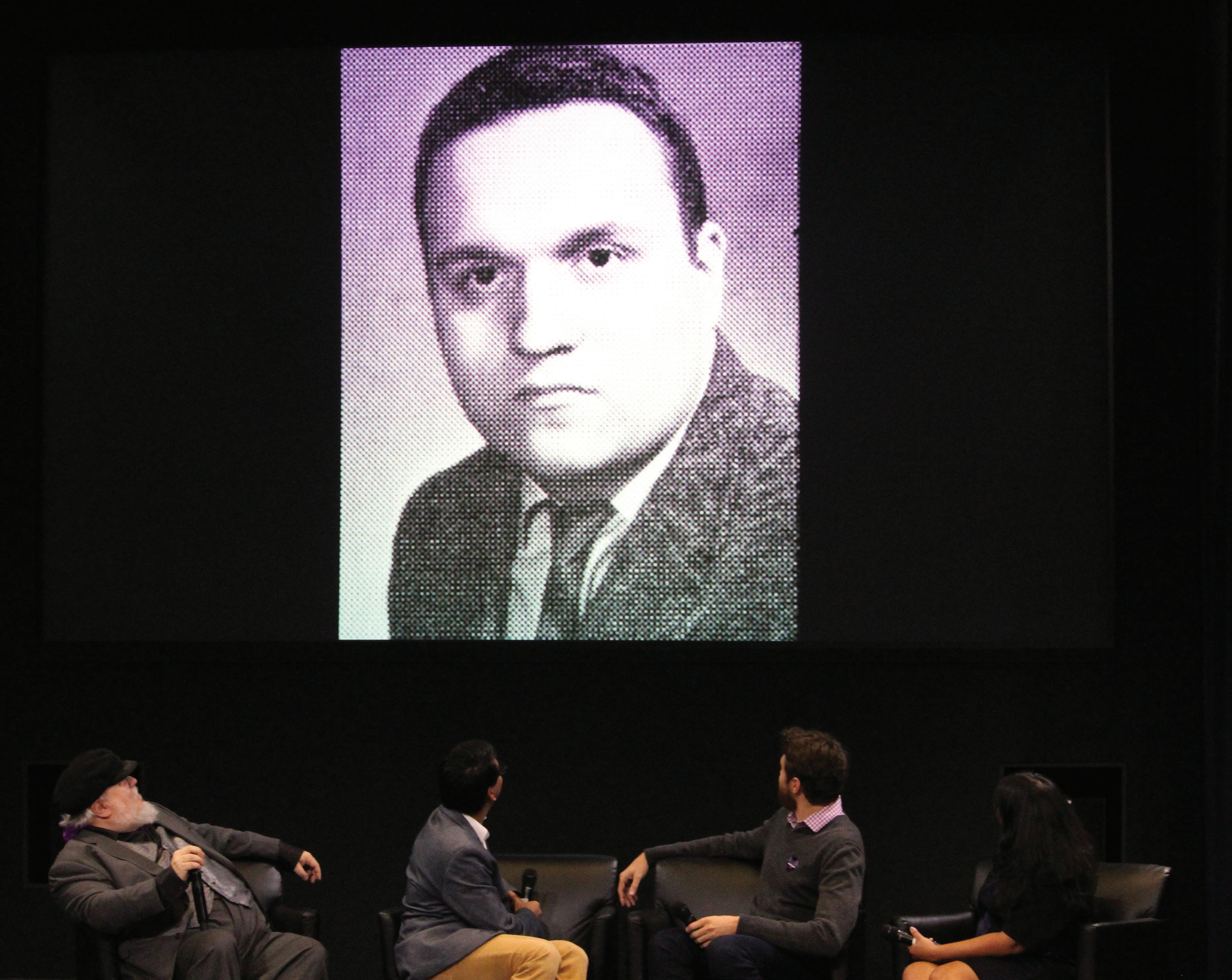
WINTER IS COMING... SIGN UP FOR YOUR SENIOR YEARBOOK PORTRAIT BEFORE IT'S TOO LATE. PHOTOGRAPHERS RETURN JANUARY 18, 2023 Sign up at: www.OurYear.com NU Code: 87150 Walk-ins welcome (but appointments have priority). questions? email: syllabus@northwestern.edu or go to: www.NUsyllabus.com GEORGE R. R. MARTIN CREATOR OF "GAME OF THRONES" CLASS OF 1970 NU SYLLABUS YEARBOOK PORTRAIT PHOTOGRAPHERS WILL BE IN NORRIS FOR A LIMITED TIME.
MONDAY, NOVEMBER 21, 2022 10 THE DAILY NORTHWESTERN
Several poses will be taken – in your own clothes and with cap and gown. Your choice will be available for purchase. All senior portraits must be taken by Prestige Portraits/Life Touch. $10 sitting fee required.
HOCKEY
FIELD
page
1
By ZOEY SOH and YIDOU WENG the daily northwestern @zzoeysoh

Business owners and residents on Howard Street hope to see more street lights, flowers and increased Evanston-Chicago collaboration with the help of a new grant.
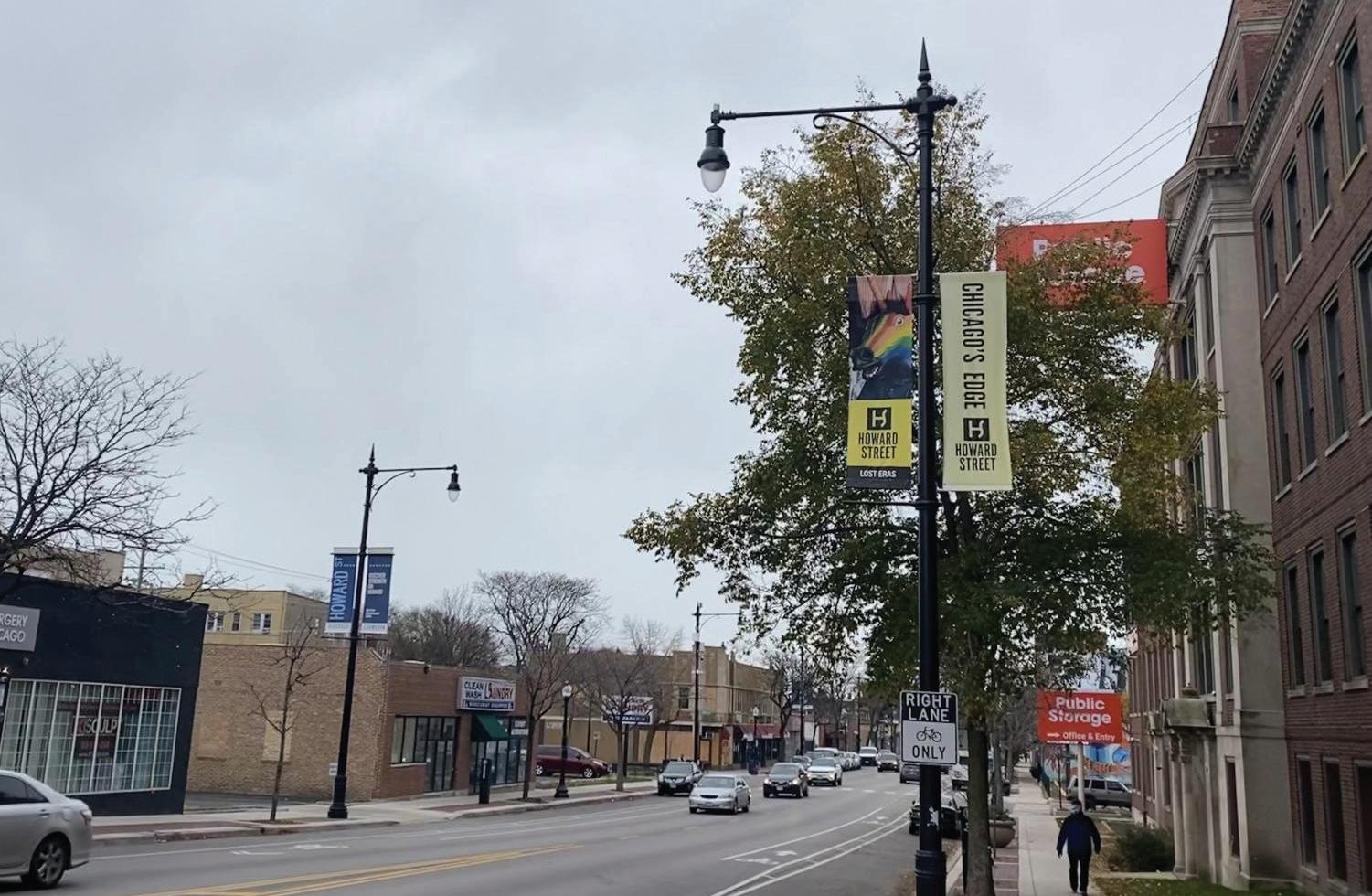
The Rogers Park Business Alliance and the city of Evanston plan to use a more than $99,000 economic recovery grant from the Research in Illinois to Spur Economic Recov ery Program for a joint study on the impacts of the COVID-19 pandemic on Howard Street.
The street acts as the border between Evan ston and Rogers Park. The study will inform an action plan to revitalize the area and improve communities on both sides of the street.
Shyvonne Leslie, a business manager at Good To Go Jamaican Cuisine, said her busi ness has still not returned to pre-pandemic customer levels.
She emphasized that beautification could help bring in more customers.
“I definitely want more street lights because it tends to get a bit dark around here,” Leslie said. “Of course you want it to be beautiful, so you want to do flowers and trees.”
Business owners and residents said they also hope that the partnership will bridge gaps between the two communities.
Although the street is only a geographic divide between Evanston and Rogers Park, Rogers Park resident Michèle Lamothe said it’s representative of other differences as well.
Lamothe owns a salon on Howard Street and said she hopes the grant will help unify busi ness standards across Chicago and Evanston on Howard Street.
“There is a little bit of division,” she said. “I just think that you get two different experi ences, and we’re right across the street from each other.”


Historically, Leslie said, Evanston and Chi cago’s sides of Howard Street have operated independently. According to Block Club Chi cago, this is the first economic effort that has focused on both sides of Howard Street, as opposed to just one or the other.

Leslie said business owners have tried to

pull the two sides of the street together in the past, but they have been unsuccessful. She’s hopeful the partnership will bring beneficial collaboration.
“[Rogers Park and Evanston] could have a sister relationship.” she said. “You could advise your sister, ‘hey, if you need assistance with creating your website, this is a person that you could go to.’”
Badara Diakhate has been the owner of Badou Senegalese Cuisine in Rogers Park for 35 years.
Diakhate has seen how sharing resources
could bring the two sides of the street together for the better. They said their SenegaleseCaribbean fusion food is a result of years of collaboration with the Caribbean restaurants across the street –– on the Evanston side.
After promoting their fusion food, Diakhate said they “started getting people from Evanston coming over here, daring to cross the street.”
Businesses remain hopeful the grant will aid in the revitalization and eventual cohesion of Howard Street. Diakhate said business owners are the ones living the reality and working on
the frontier, and they hope to be consulted in the rollout process.
Diakhate said they envision a Howard Street that embodies community and is appreciated for its diversity.
“Hopefully, we’ll be a hub for ethnic restau rants,” Diakhate said. “And it’s in the making.”
The Rogers Park Business Alliance declined The Daily’s request for comment.
zoeysoh2023@u.northwestern.edu yidouweng2022@u.northwestern.edu
Take NU with you, wherever you go. Sign up for The Daily's email list to get the headlines in your inbox. The Daily Northwestern Email Newsletter Sign up at: dailynorthwestern.com/email FOLLOW US ON SOCIAL MEDIA FOR THE LATEST BREAKING NEWS TWITTER & INSTAGRAM: @thedailynu FACEBOOK: thedailynorthwestern For news, updates and campus photography, follow The Daily on Instagram: @thedailynu MONDAY, NOVEMBER 22, 2022 THE DAILY NORTHWESTERN 11
to revitalize Howard St.
Economic recovery grant
Zoey Soh/The Daily Northwestern
Howard Street borders Evanston and Rogers Park. Business owners and residents hope that the economic recovery grant would bring the two sides of Howard Street together.
CROSS COUNTRY
Wildcats come in 30th in NCAA Championships
By KATE WALTER daily senior staffer @katewalter03
Northwestern finished 30th in its first appearance at the NCAA Division I Women’s Cross Country Championships since 2002, capping off a historic season for the Wildcats.
While the Cats had hoped to per form better at the Big Dance, Coach Jill Miller said she is still proud of their record-breaking efforts this season.
“I know it’s hard to end on a note that you maybe didn’t achieve the goals that you wanted to at the national championship,” Miller said. “But as we look back, there are so many historical moments for this group.”
In the women’s 6,000-meter, graduate student Rachel McCardell crossed the line with a time of 20:43 — good for 116th place — as NU’s leading runner. Last season, McCa rdell qualified for the national meet as an individual and took 82nd.
Graduate student Ari Marks was next, finishing 161st with a time of 21:01, followed by junior Katherine Hessler in 173rd and sophomore Ava Earl in 195th. Senior Kalea Barto lotto, sophomore Anna Hightower and graduate student Olivia Verbeke rounded out the Cats’ performance,
placing 218th, 223rd, and 244th, respectively.
During its last trip to the Big Dance in 2002, NU also took 30th, with Rachel Evjen finishing first for the team in 89th.
Earl said the team took away many lessons from competing on the national stage.
“It was a huge learning experi ence,” Earl said. “We didn’t execute the way we wanted to, but I think that we really went in with a great head space that we have had all season.”
NC State defended its 2021 national title on Saturday by placing first in a field of 31 teams, with junior Katelyn Tuohy winning the women’s race. New Mexico and Alabama fin ished second and third, respectively.
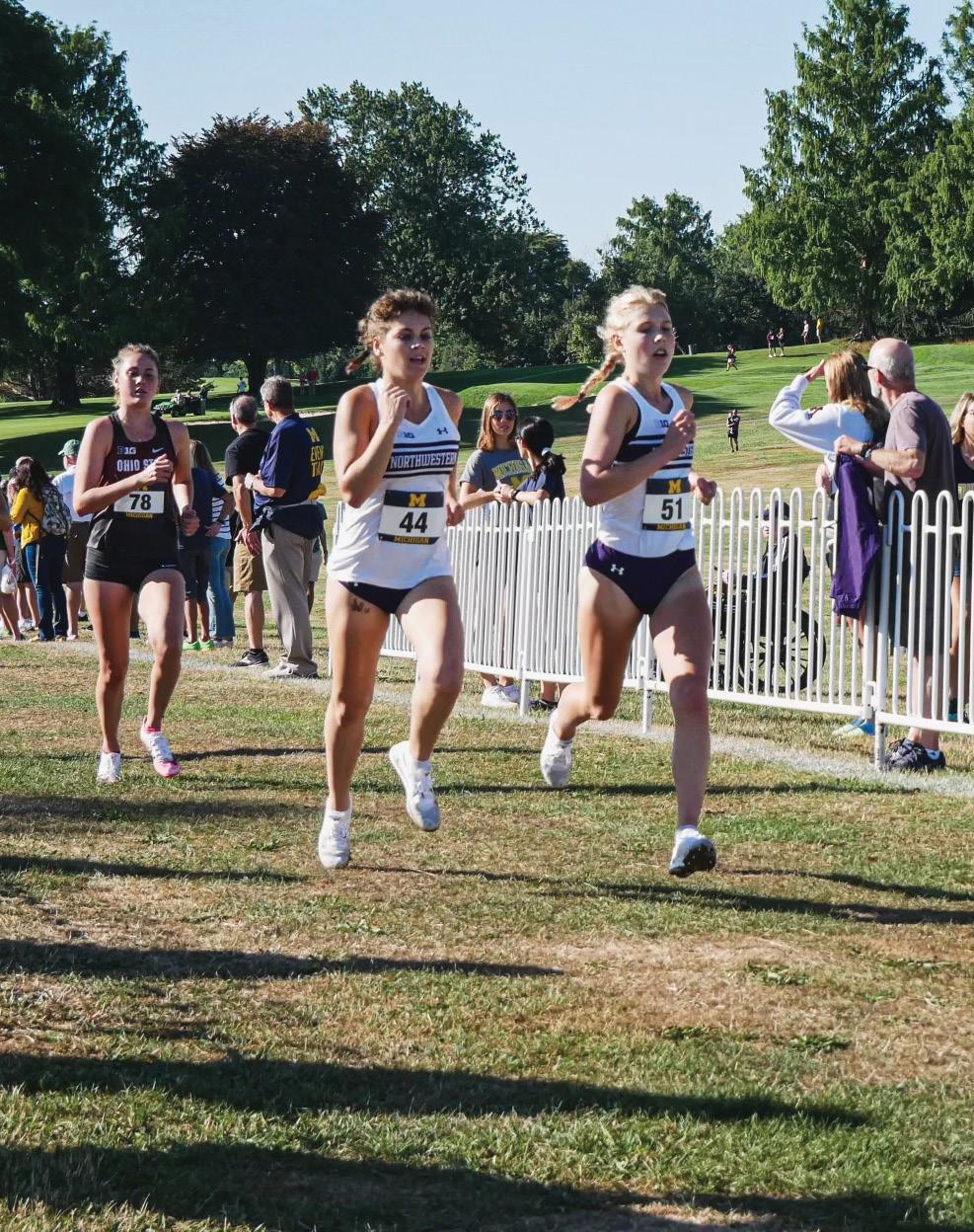
Oklahoma State, who took first to NU’s second at the Midwest Regional Championships, finished fourth over all. The Cats were one of five teams in the Big Ten to qualify for Nationals.
Miller said the field at the meet was incredibly deep, particularly with runners using an additional year of eligibility earned through NCAA’s pandemic rules.
Saturday’s race concluded a record-breaking season for the Cats. After a string of solid performances, NU broke into the national rankings at No. 29 in October for the first time since 2002.
The Cats took fifth at Big Ten
FIELD HOCKEY
Championship in their first meet of the postseason, marking their highest finish at the conference meet since 1986. NU punched its ticket to the Big Dance with a second-place finish at the Midwest Regional Champion ships, where four Cats also received All-Region honors — the most in program history.
While the team fell short of its goals at the NCAA Championship, Earl said she is proud to be part of its history-making season.
“I would so much rather have like a bad race on this team than like a million good races on any other,” Earl said.
The past few seasons under Miller have signified impressive growth for NU, after placing 13th — near the bottom of the rankings — at both the Regional meet and the Big Ten Championship as recently as 2019.
Miller said she encouraged her run ners to apply lessons from the NCAA Championship and the rest of the sea son to other aspects of their life.
“Athletics is something we do to teach them how to be successful in life,” Miller said. “(It teaches) how to achieve things collectively as a group that maybe nobody else thinks that they can because of a big vision and commitment towards a collective goal.”
katewalter2025@u.northwestern.edu
Swann: NU’s offense led to loss Cats make a statement at home in defeat of SIU
By SKYE SWANN daily senior staffer @sswann301
In its final matchup on the biggest stage, Northwestern fell short against an undefeated North Carolina team, losing the NCAA Division I Field Hockey Championship.
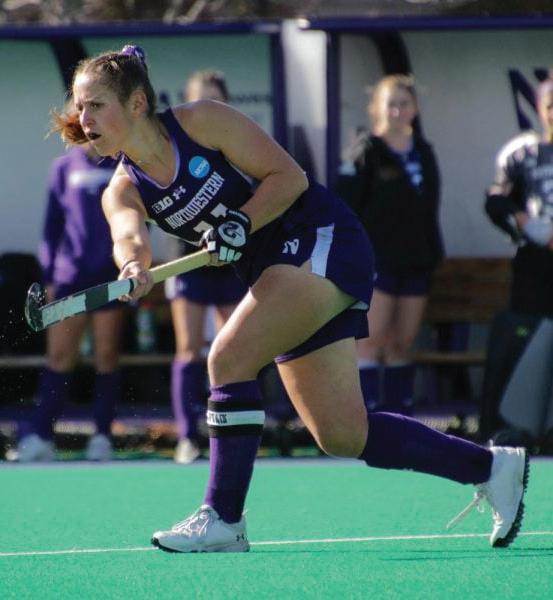
The Wildcats walked into Sunday’s contest as the underdog, battling a gritty Tar Heels program. Nonetheless, North Carolina’s reputation speaks for itself after earning three back to back championships from 2018 to 2020. Although NU entered Storrs, Connect icut as the reigning champs, its hard fought efforts were fruitless against a powerhouse of a program.
“North Carolina was really feisty today,” coach Tracey Fuchs said. “They were upsetting our play. We weren’t connecting as good as usual.”
The Cats struggled to pick up the pace early on. A concern throughout the season, NU moved visibly slower on the field in comparison to the Tar Heels, losing in transition and strug gling with the ball inside the sixteen.
Further into regulation, the Cats worked to find a spark on the offensive end, seeking more looks at the cage. However, the squad could not pull it together before the end of the first half. Fortunately, the Tar Heels were scoreless as well, so it was still an equal matchup through the next 17 minutes.
And yet, NU made minimal adjust ments for the next two periods, still struggling to speed up its game and becoming more gritty on the offen sive end. The defensive side was put to the test, fighting off a high-attack ing opponent who was working tire lessly to obtain a goal. Ultimately, it succeeded. North Carolina executed, scoring a clean goal that slid right past junior goalkeeper Annabel Skubisz.
After their win to secure a Final Four appearance, the Cats were working on improving their reactiveness on the ball, Skubisz said. But, NU remained passive, taking a long time to get a cor ner and making careless miscues that
caused forceful turnovers.
In Friday’s matchup to Maryland, the group was strong and had control of the game. On Sunday, it was the complete opposite.
“If we would have (kept our sticks on the ball more) in the first half, it might have been a little bit different, but (we) can’t go out there and change that outcome,” fifth-year defender Kayla Blas said.
While graduate student forward Bente Baekers scored a last minute goal to tie the game, the small glimpse of the typically-dynamic Cats only lasted a brief second. The Tar Heels made it harder for the squad to get back on the offensive end. Instead, Skubisz was put back on the front end, not saving North Carolina’s second goal, ending the game.
A bittersweet ending, NU definitely did not want to end its season with
this outcome. Now, the Cats lose core players such as Blas to graduation. But regardless of this heartbreaking end, the program will return a majority of its core team next season to go even harder.
The Cats finished their 2022 cam paign in epic fashion, notching a sec ond consecutive appearance in the NCAA Championship and making program history in hosting the NCAA Tournament. On top of that, NU wit nessed star players reaching career highs this season, putting icing on the top of the cake.
“The thing that I’m always gonna remember as my best friends, all 25 girls in that locker room are the people that make me laugh, make me smile, and that I look forward to seeing every single day,” Blas said.
skyeswann2024@u.northwestern.edu
By JAKE EPSTEIN the daily northwestern @jakepste1n
Northwestern entered Welsh-Ryan Arena on Saturday looking to make a state ment at home. The team’s last contest, a 92-58 loss at home against Notre Dame, was marred by three first half ejections and poor efficiency.
But the Wildcats (2-2,0-0 Big Ten) came back strong with a 84-69 win over Southern Illinois (0-3,0-0 Missouri Valley).
The Cats caught fire from tip-off, as sophomore forward Caileigh Walsh tallied an offensive rebound then kicked out to sophomore guard Jillian Brown for a corner three-pointer. NU scored nine unanswered points before the Salukis tallied their first basket of the game.
Led by Walsh’s powerful play inside, the Cats dominated control of the action. As the first quarter ended, freshman guard Caroline Lau faked out a Southern Illinois defender and scored a driving layup to put NU in front 25-13.
The Cats simply could not miss in the second quarter. Coach Joe McKeown’s squad made 71.4% of its field goals in the second quarter. NU also went 2-for-3 from beyond the arc to put itself firmly in control up 52-34.
“We were pretty patient in our execu tion,” McKeown said. “We got the ball inside-out. We were able to run out some turnovers and get some quicker open looks.”
While the Cats had their most prolific offensive half of the season, the team’s defensive efficiency raised some concerns. The Salukis made 46.7% of their second quarter shots, and center Promise Taylor gave NU all sorts of problems inside.
At the start of the third quarter, Taylor kickstarted a 6-0 run for Southern Illinois. The Cats ran into all issues in the paint with the Washington native, who led the Salukis with 20 points.
SIU’s quick start to the second half stalled as the third quarter ran on, and NU once again seized control of momentum
by the quarter’s end.
Walsh, who was ejected in the second quarter of last Wednesday’s matchup against Notre Dame, looked at ease throughout the contest. The New Jersey native knocked down an early fourth quar ter three-pointer and made one final basket to tally a career high 24 points.
“I knew that it was my get-back game,” Walsh said. “That game against Notre Dame meant so much to me, and obviously it was taken away. But, that’s how life goes sometimes. I just had to get my head right, and all (of) my teammates and coaches had my back.”
The Salukis held the Cats to their worst shooting quarter in the final period, as they converted just 5-for-15 from the field. However, it was too little too late for Southern Illinois, as NU finished with a victory and its highest scoring output of the season.
Still, questions remain about the Cats’ shortcomings on the boards, as they lost the rebounding battle for the second straight game. After getting dominated 58-32 by the Fighting Irish, NU was outrebounded 43-35 Saturday.
“(It’s) a big concern — not just numbers wise — but (on) different places on the floor,” McKeown said. “Mis-rebounding on missed free throws — that can’t happen. Fundamentally, you can’t let it happen, and (on) long rebounds I felt like we got beat to the ball.”
The Cats return to play against Niagara (1-2, 0-0 Metro Atlantic Athletic) on Tuesday at home. On the back of a twogame losing streak, and with their most recent game postponed due to inclement weather, the Purple Eagles look to steal a win in Evanston
McKeown said he is excited for his young squad to gain more experience before Big Ten play begins.
“I see some really great potential in this team,” McKeown said.”We’ve had a lot of injuries, (and) we haven’t practiced a lot. We’ve challenged our team with this schedule.”
SPORTS Monday, November 21. 2022 @DailyNU_Sports
MEN’S BASKETBALL
jakeepstein2026@u.northwestern.edu
Photo Courtesy of Megan Slamkowski
Daily file photo by Angeli Mittal



































